

Catch Fish with
Mike Ladle
Information Page
SEA FISHING
For anyone unfamiliar with the site always check the FRESHWATER, SALTWATER and TACK-TICS pages. The Saltwater page now extends back as a record of over several years of (mostly) sea fishing and may be a useful guide as to when to fish. The Freshwater stuff is also up to date now. I keep adding to both. These pages are effectively my diary and the latest will usually be about fishing in the previous day or two. As you see I also add the odd piece from my friends and correspondents if I've not been doing much. The Tactics pages which are chiefly 'how I do it' plus a bit of science are also updated regularly and (I think) worth a read (the earlier ones are mostly tackle and 'how to do it' stuff).
Lure fishing in the 2020s - Part X
The last word – what I use and why!
What is lure fishing to me?
As far as I’m concerned ‘lure fishing’ is using an artificial ‘bait’ to attract and catch fish. So, I consider most of the flies that I use as ‘tiny lures’, but since there is a wealth of information written about fly-fishing, and I’m no great shakes as a fly caster, I shall mention only a few artificial lures (= flies) which are too small and light for me to cast on conventional spinning tackle without the addition of extra weight. In general, I’ll say nothing about conventional fly fishing for trout, grayling and the like or the use of imitation maggots or maggot-flies for mullet, even though I've done a lot of the latter.
Although artificial lures have many advantages - they are easy to obtain and light to carry, they are attractive to a wide range of species, they are exciting to fish with and you can, if you are so inclined, design and make your own (the huge popularity of fly tying shows that this aspect of do-it-yourself appeals to many anglers) - they are not always the best way to catch fish. Having said this, lures are often the quickest means of putting numbers of fish on the bank, particularly when the predators are in a feeding frenzy, (because you can almost immediately be in action again, after each catch or missed fish). However, as a rule, live or dead prey animals (natural baits), will often have the edge over artificials; particularly when bites are hard to come by or in terms of fooling the larger fish to take your hook. Nevertheless, I and many other anglers, spend most of their fishing time casting artificial lures and enjoying it immensely.
Spend a fortune on lures??? (or do as I do?)
I’m not a ‘lure collector’ in any sense. Over many years I’ve tried a lot of lures with varying degrees of success. These days, conventional artificials - pirks, wedges, jigs, spoons, spinners, plugs (with or without lips), poppers, soft-plastics, shads and weedless-softbaits - are all available in a vast range of sizes, shapes and colours. Most of these will catch fish (given the right conditions) and some are more effective (occasionally much more effective) than others.
If you weed out the cheapest, poor quality, rubbish, with crude hooks, weak attachments and so on: and if you avoid designs which make the lures difficult to cast (for example, those that 'catch the wind' or fold back on the trace) or which don’t spin/wobble/wriggle freely, or don’t behave as intended in the water; what remains?
Well, there are still a great many worthwhile lures on the market at prices ranging from quite reasonable to eye-wateringly-expensive. Why do I mention price? Surely if the lures catch fish the price is irrelevant? Perhaps not! Consider, if you are about to cast almost £30s worth of lure into a spot surrounded by trees, bushes, rocks, kelp, etc.; unless you are super-rich, there may be a (subliminal?) tendency to hold back on the cast, and let it fall short or to one side of the potential graveyard. This is not good. If a cheaper, more expendable lure might be just as effective (and that is likely) and so allow you to free-up your casting arm – USE IT. That cast could produce you the fish of a lifetime. (The truth is I’m a tight fisted old sod).
In the following section I shall describe the lures that I use most (my usual first selections) for the major species that I seek (listed alphabetically). I shall deal with the fish that I catch here in Dorset and with the ones that I commonly catch on my annual holidays in foreign parts. They all work well and catch me plenty of decent fish. They are by no means the only lures that will tempt fish to strike, and there may well be better ones, (many of my fishing pals use a range of different lures). However, after sixty-odd years of trial and error these are the ones I've settled on. For each species I shall list them in order of my choice. So, the first one (or two) will be my GO-TO lure(s) (Number 1.) and the following ones (2. 3. etc.) are those that I often use for particular conditions (or just a change). Of course, it’s not quite that simple because, on the odd occasion, problems with weather, weeds or prey abundance may dictate what comes out of the bag first. However, if these were the ONLY lures I had, it is unlikely that my catches would be much reduced.
Bear in mind that, I'm always fishing from the sea shore or the river/lake bank and I only paddle or wade if it is absolutely essential. No doubt many anglers will disagree with my selections and most individuals will have their own favourites - which they are quite free to argue the toss for. However, if you think about it, there are a limited number of lure types and virtually all the ones available fall into about half-a-dozen basic forms. So, it all boils down to the fact that:-
You can buy many variations of most of the standard types and they will differ in size, shape, weight, visibility (colour, contrast, brightness), floating-sinking, built in depth control (plugs), built in action (vibrate, wobble, wriggle), angler initiated action, weedlessness. In my experience, whatever you may have read to the contrary, constantly fiddling about with these details will rarely make much difference to what you catch. Confidence is ninety percent of the battle.
Bass
1. Weedless soft plastics are always a good first choice for bass fishing. They can be used virtually anywhere, any time and in any conditions. The ones illustrated, when properly fitted with sharp, Texposer or similar crank-shanked hooks, don't miss many takes. A cone lead may be slid down the trace to the nose of the lure if you need more distance or depth – I usually don’t bother. Unweighted, and wound a bit faster they can double as surface lures. The Redgill Evo-Stix is a good all-rounder but it’s a bit small. Home-made Slandras or Slug-Gills can be much bigger, and catch equally well or better. The weedless, Fiiish Black Minnow is currently very popular (and a good catcher), but it’s relatively expensive, it is weighted (even the resin head is quite chunky), a bit fiddly, and quite fragile. The basic, 18cm, Evo-Redgill is also good and has a dorsal hook position to reduce the risk of snagging, but it has a fixed internal weight. The projecting hook of this (or the plain, old-fashioned Redgill) makes it more likely to snag than its 'weedless cousins'. All these lures are consistent bass catchers in white, pearly or translucent versions, so I don't carry a range of rainbow colours.
The Evo-Stix - virtually snag free and weedless and effective for bass. Basically, white versions are fine.
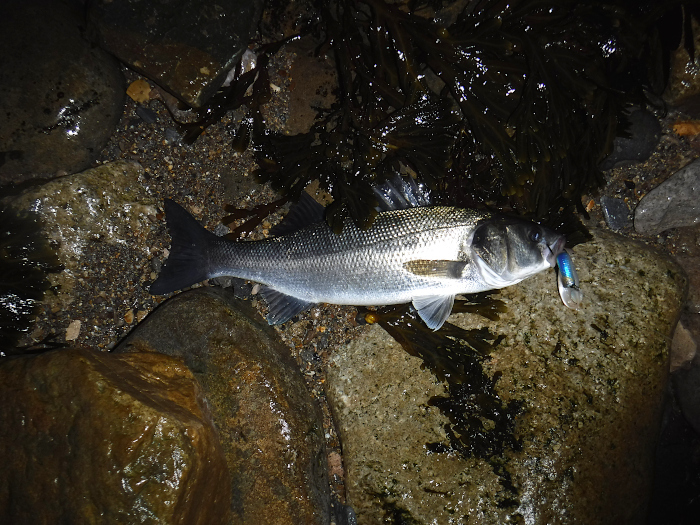
The 'Slandra' - my home-made fusion of a weedless Slug-Go and a wriggling Super Sandra - these can be larger than the Evo-Stix and again white is OK.
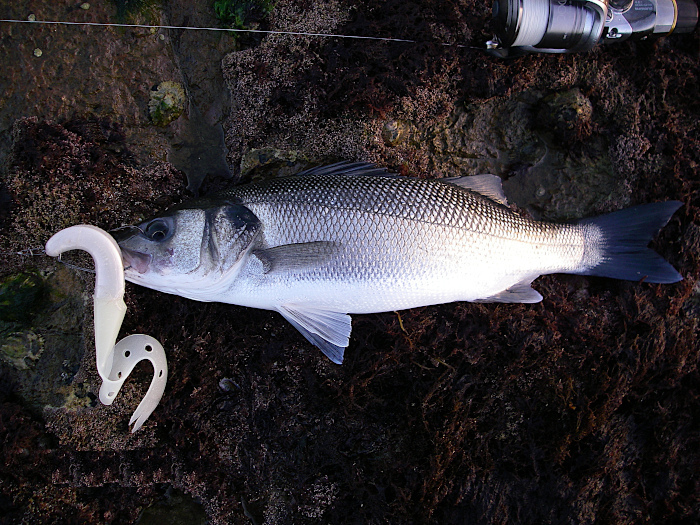
My pal Bill Fagg catches lots of bass on hybrid 'Slug-Gills', which are his original, bigger prototypes of the commercial Evo-Stix.
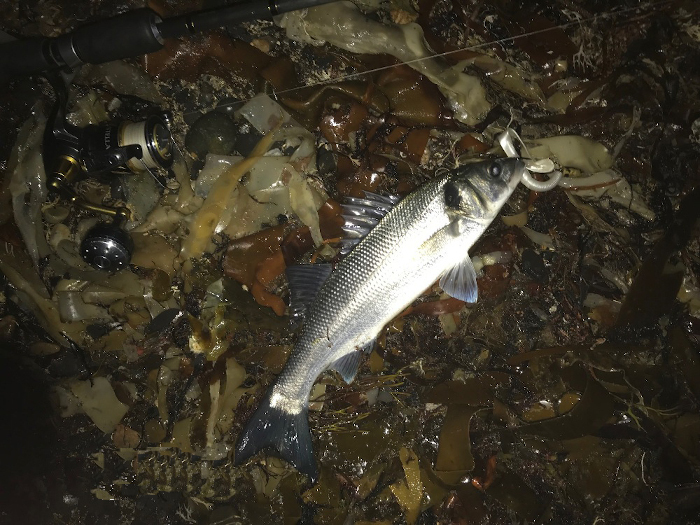
The 18cm, Pearl (white), Evo-Redgill.
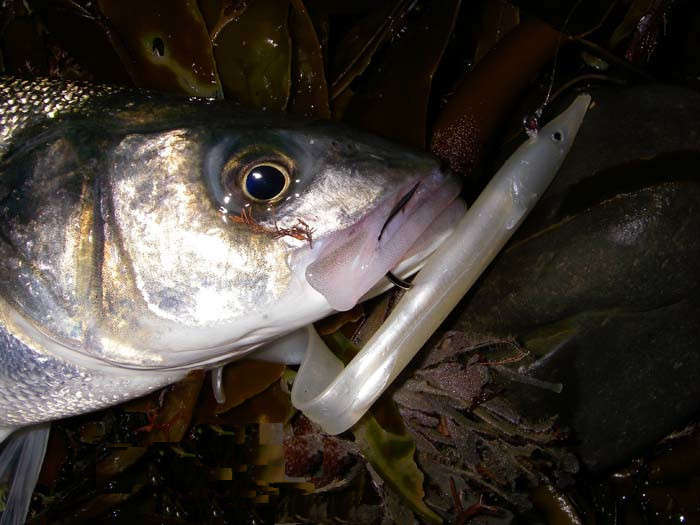
2.Buoyant, shallow-diving plugs are still excellent bass lures, both jointed, balsa ones like Rapalas and the many unjointed (and jointed) plastic versions. They float until they are retrieved and so are very good in shallow water, but being fitted with two trebles (or replacement singles) makes them liable to catch unseen snags and/or pick up weed.
The'old faithful', 11cm Rapala in black and silver..
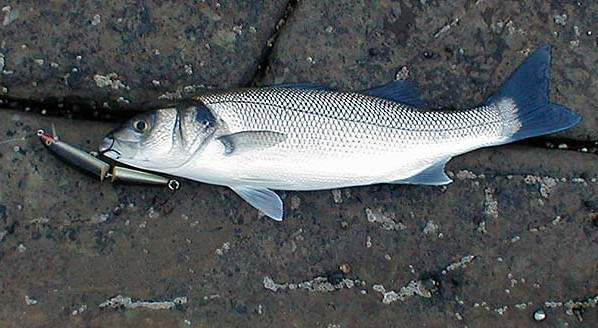
A one-piece, shallow diving, hard plastic plug.
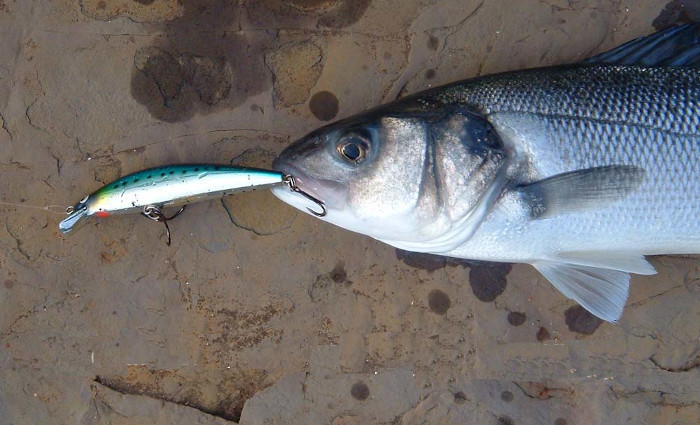
3.Poppers and sliders fish on the surface, so they are useful over really shallow snags; with twitches and pauses they give exciting takes and they cast well. Probably most effective in warm weather and calm conditions.
The Skitterpop is an attractive (to bass) surface splasher/popper.
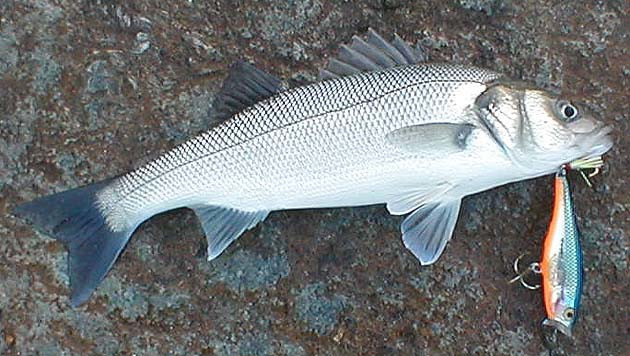
A long casting, surface fishing, slider.
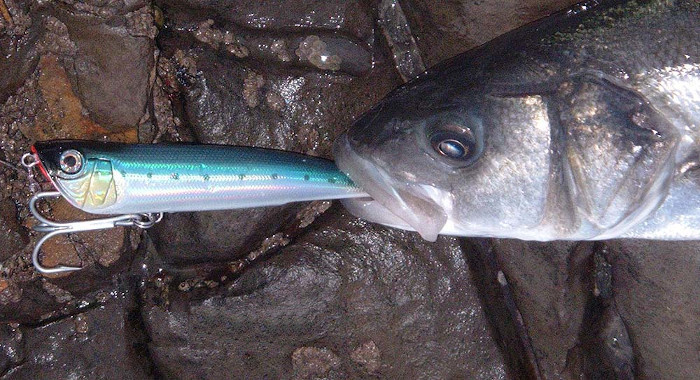
Barracuda
1.Surface lures are effective for these fish when retrieved quickly in the surface film. Barracuda will take a variety of lures (plugs, spoons, softbaits, tube-lures) generally retrieved as fast as possible. Barracuda strike so quickly that it is almost impossible to wind fast enough to avoid them. Soft plastic lures are soon destroyed by the teeth of these fish.
A barracuda taken on a fast moving Skitterpop.
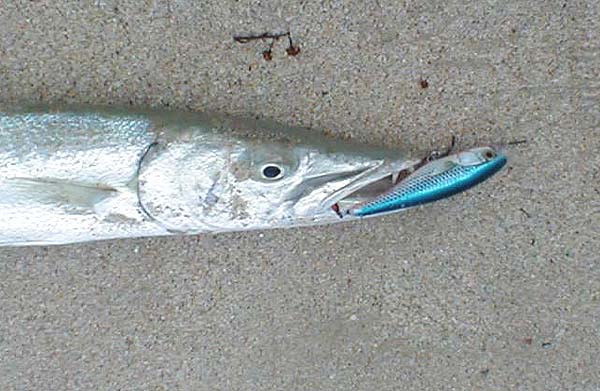
...and one on a yellow, shallow-diving, hard-plastic plug.
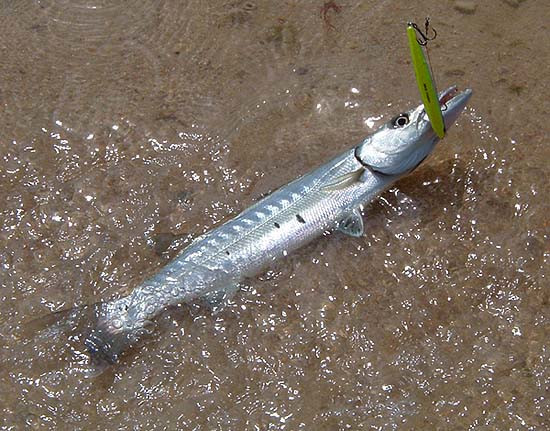
...another on a long slider.
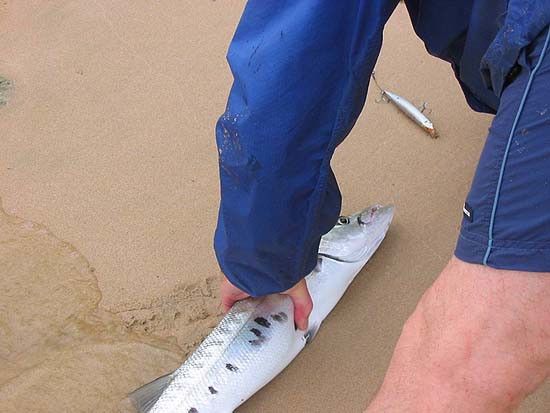
A decent barracuda caught on a lure by my son Richard.
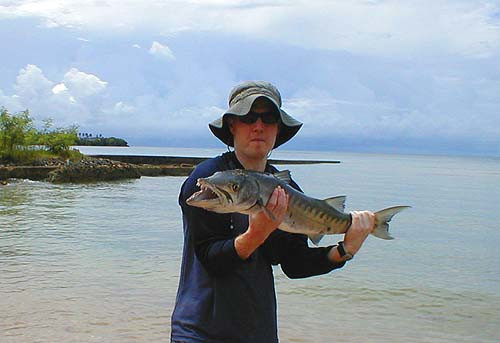
Bluefish.
1.Single hooked metal pirks or wedges are good for bluefish: this is another toothy fish that takes spoons and pirks well. Hard lures withstand the effects of their teeth and strong jaws. A wire trace is essential.
A good bluefish caught on a single-hooked wedge.
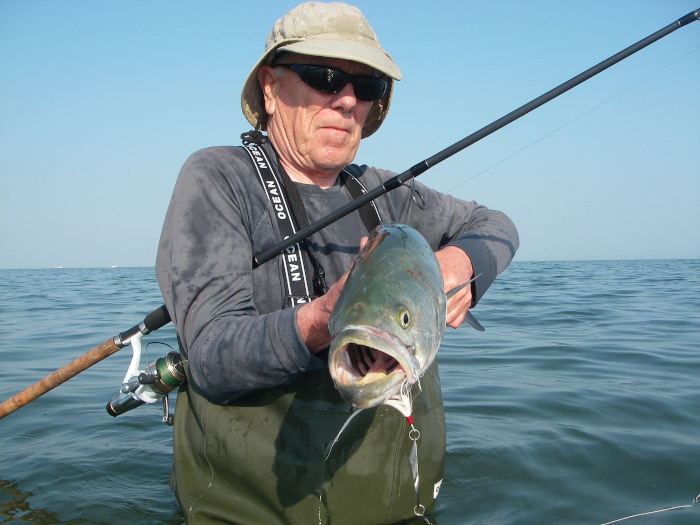
2.Lead headed jigs are also good but very vulnerable to the sharp teeth of the fish.
...this one took a softbait on a jig-head.
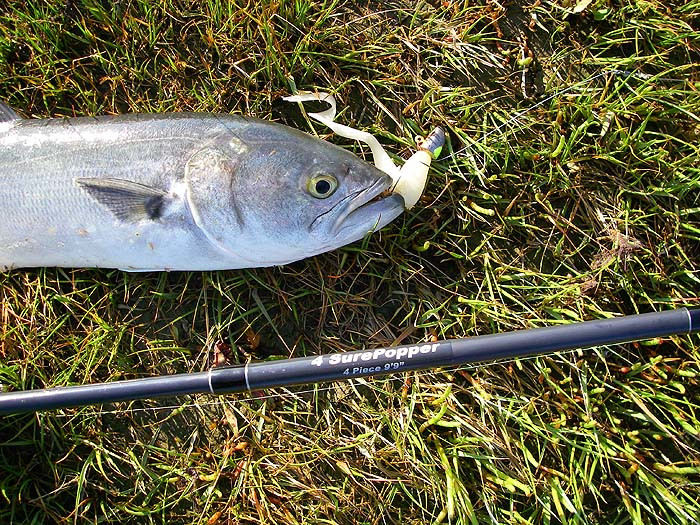
The result of blufish dentition on softbaits.
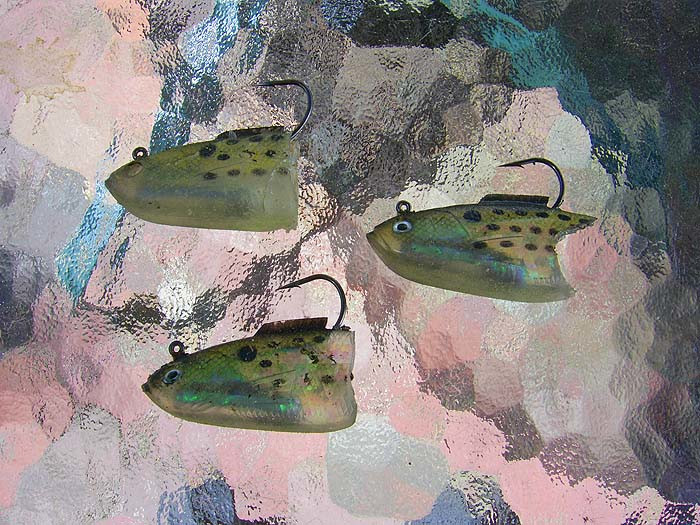
Bonefish.
1.The 7cm jointed Rapala is an excellent bonefish lure but other (some rather larger) shallow-diving plugs also work well. Make sure that the hooks are good ones and that you have spooled plenty of braid, as these fish run, unbelievably hard. The traditional approach to catching bonefish is to use fly tackle but they take lures surprisingly well.
Bonefish run just as fast and far on spinning tackle.
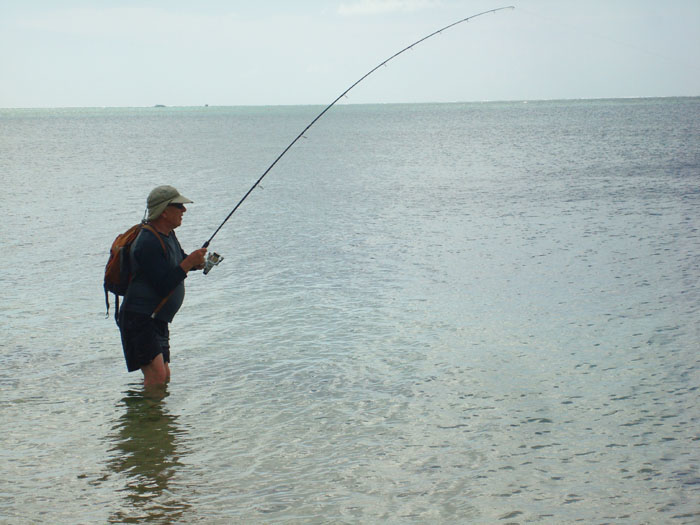
A bonefish taken, over the seagrass beds, on a buoyant, jointed Rapala.
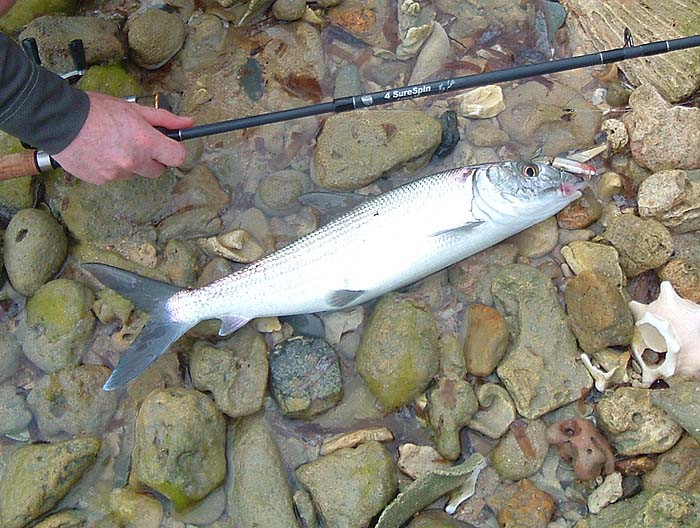
Another fine bonefish on the spinning gear.
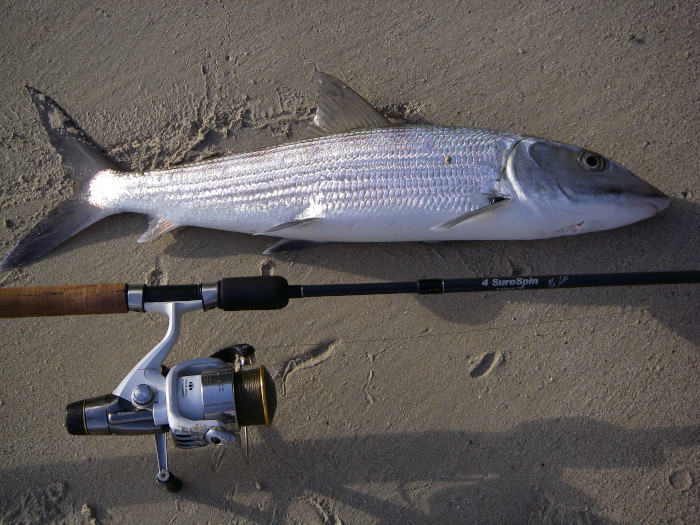
2.Bonefish will sometimes take surprising lures.
Unusual - this beauty grabbed the tail of Steve's slider intended for barracuda.
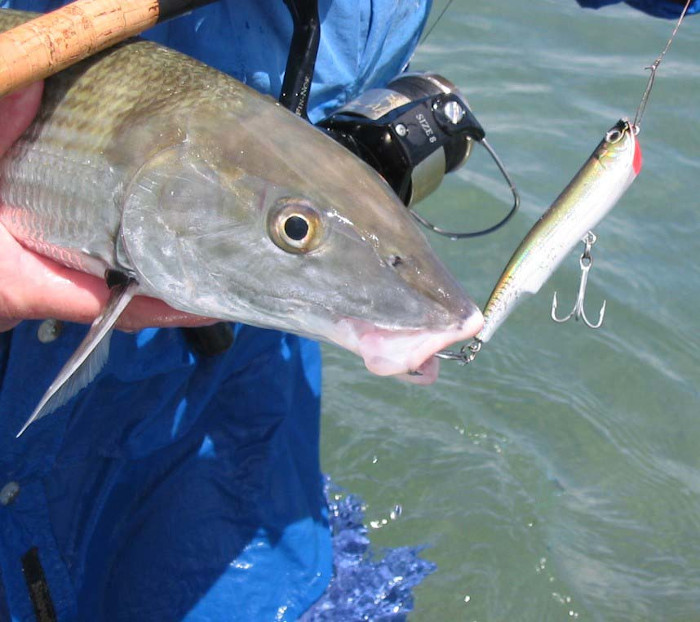
Chub.
1.7cm-11cm jointed, buoyant Rapalas are extremely effective lures for chub, but the fish are not particularly fussy and will take a range of lures. Floating plugs are good because they often tempt fish even as they splash down and lie ‘dead’ on the surface of the water.
A nice chub on a Rapala.
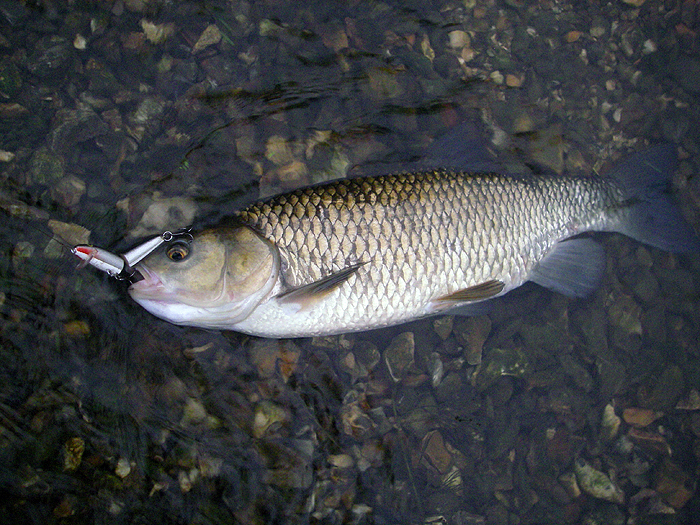
Another decent chub
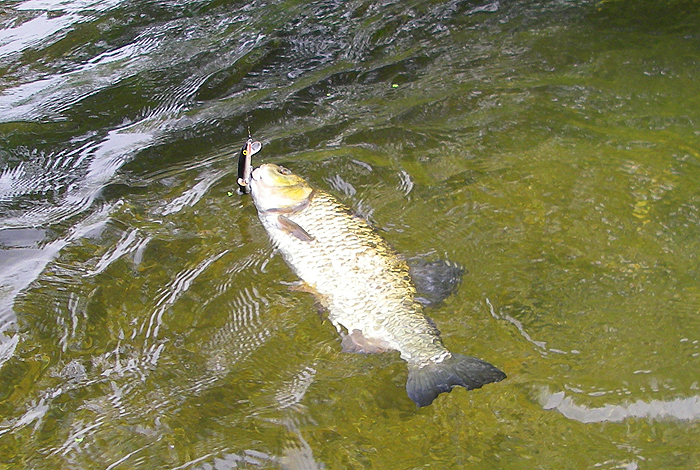
2.Mepps spinners will also catch chub, but they are less versatile than buoyant plugs. I always fish with a trace of knottable wire, because pike are usually present, the wire doesn’t put off the chub or perch as far as I can tell.
A nice fish on the Mepps
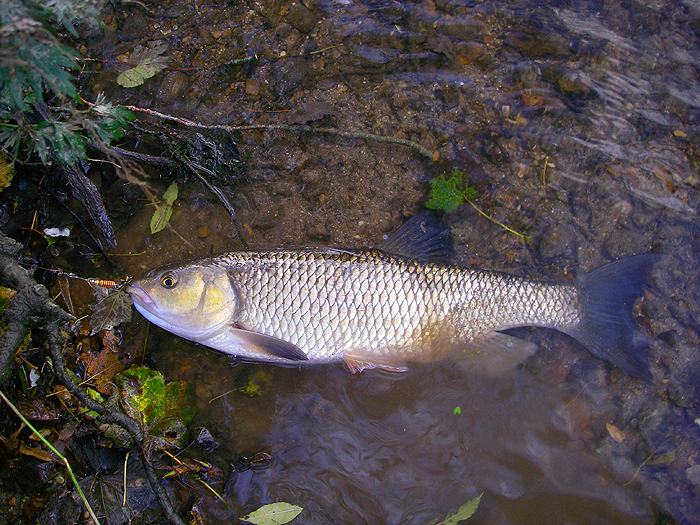
Another one that fancied a spinner
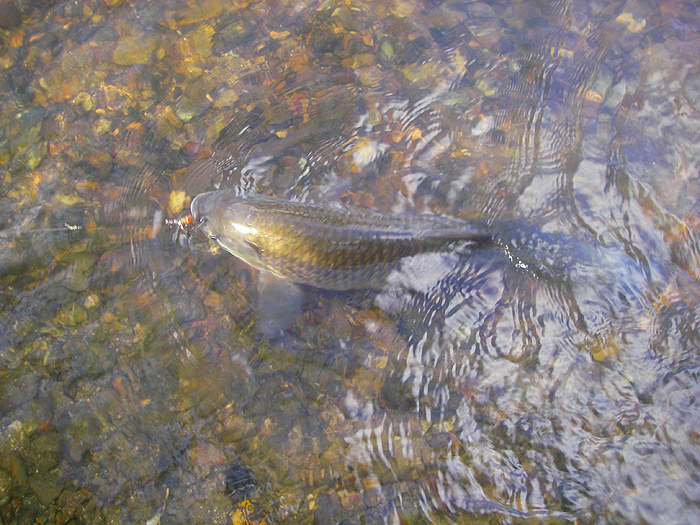
Typical big-chub spot
– Overhanging trees like this are ideal for chubbing with a buoyant plug (but also good for losing an expensive lure)
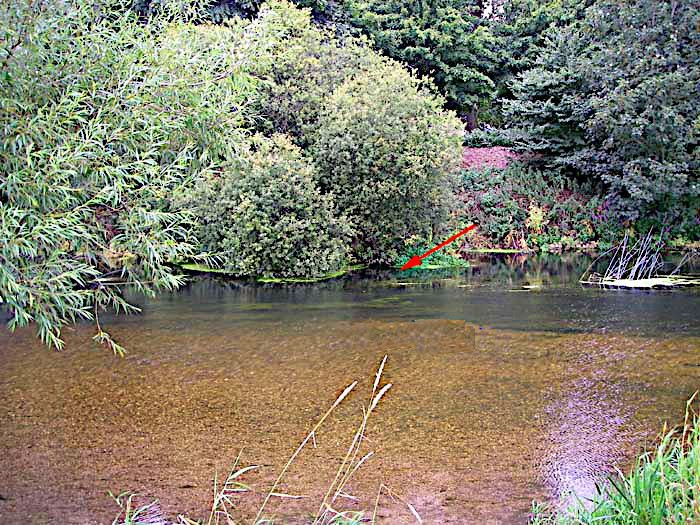
Jacks.
1.Sliders and poppers are very good lures for jacks as they can be cast a long way ‘quickly’ (because blitzing jacks don’t hang about waiting for you to get a lure to them) and can be retrieved fast (which they like to attack). Strong hooks (3-4x) are essential for these fish. Single-hooked spoons and wedges also work well.
A good jack taken on a slider.
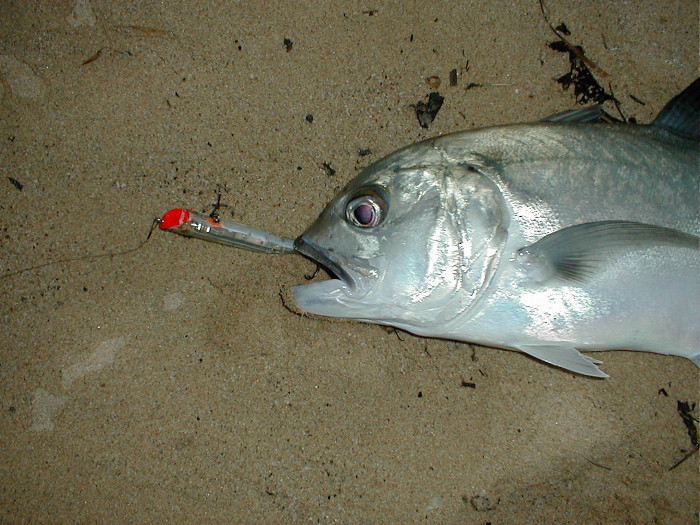
There will certainly be differences in the behaviour of different species of jacks/trevally, but the larger ones take surface lures well.
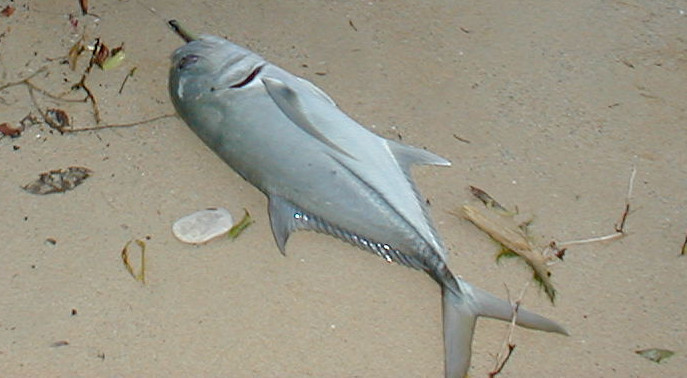
Steve's giant trevally was caught on a big surface lure when he fished in the Seychelles.
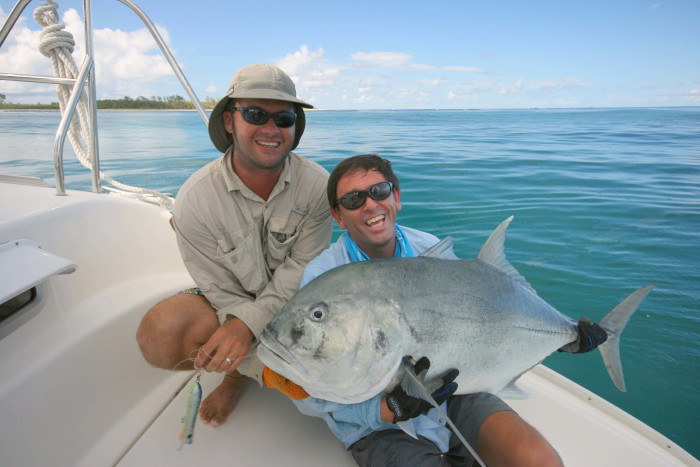
There's nothing pulls like like a big jack. This one was hooked on a Skitterpop, from the beach, in the evening. I’ve been spooled more often by these fish than any other (not that often!).
Any big jack hooked from the shore is an unforgettable experience.
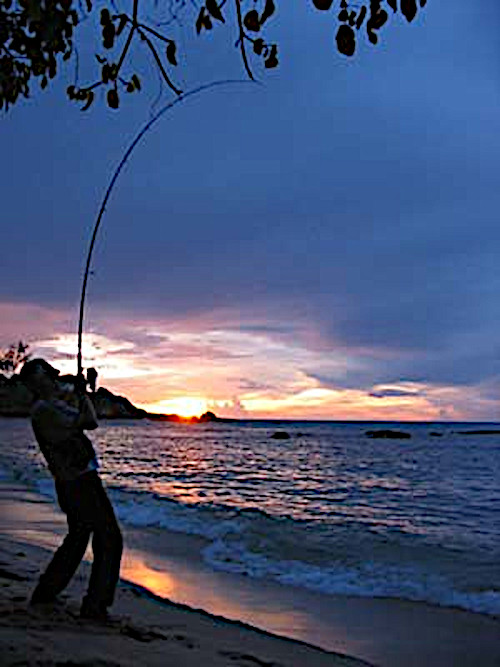
Garfish and houndfish.
1.Spoons, plugs, surface poppers and flies all catch garfish, but because of the slim beak a small fly (or a bait) is often the most effective thing to use.
A garfish caught on a Toby spoon - they are often attracted but not easily hooked on these.
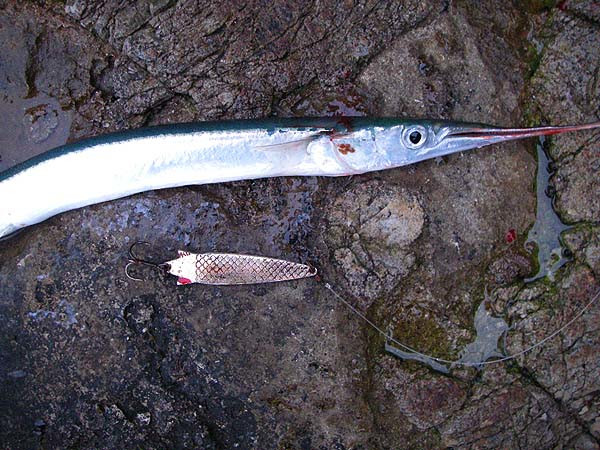
...one on a fly - probably the best lure type for these fish.
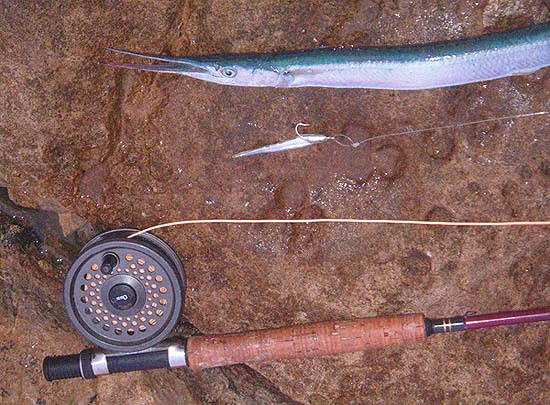
...and, unusually, this one hooked itself on a slider.
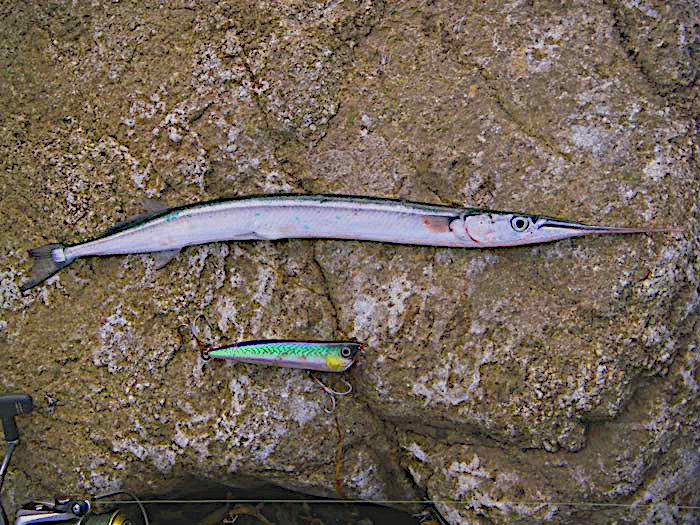
2.The same range of lures will also catch houndfish (which are like giant gars and fight in proportion to their size) in tropical seas, but all lures need a wire trace – look at those teeth! Even our own gars will nip through fine nylon.
A cracker caught from the shore.
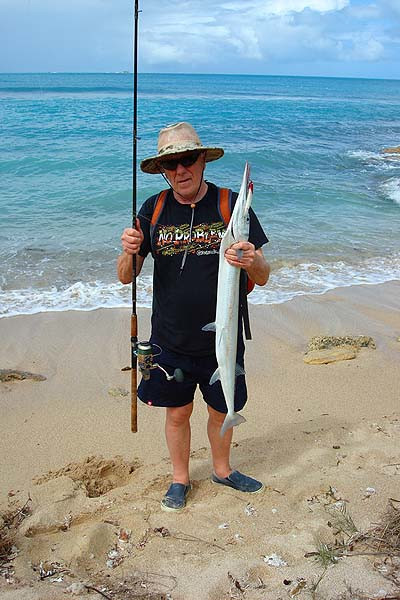
A close up of the toothy jaws of a big houndfish.
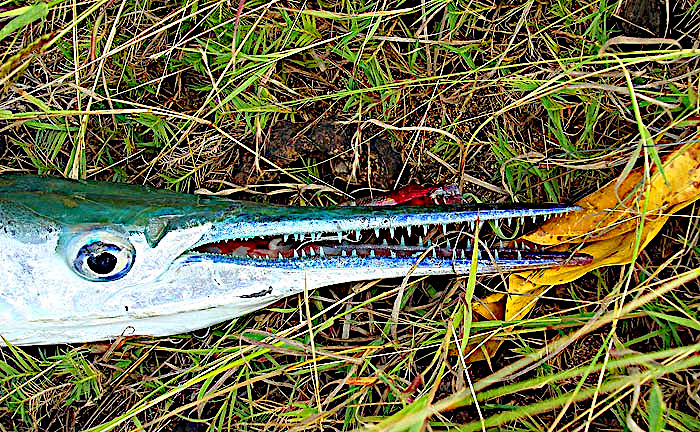
Mackerel.
1.Metal spoons and wedges (small pirks) are the usual go-to lures for catching mackerel. If you want the fish to be in good condition (e.g. for live-bait? or to shake them off the hook and let them go?) use a single hook and flatten the barb, as the mouth of a mackerel is very brittle.
A wedge gives the option of distance casting if the fish are further offshore.
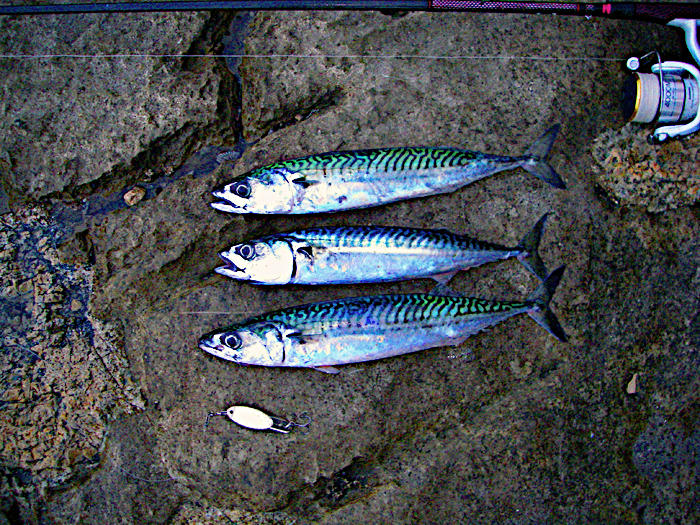
A Toby with a single hook often keeps the catch in good condition.
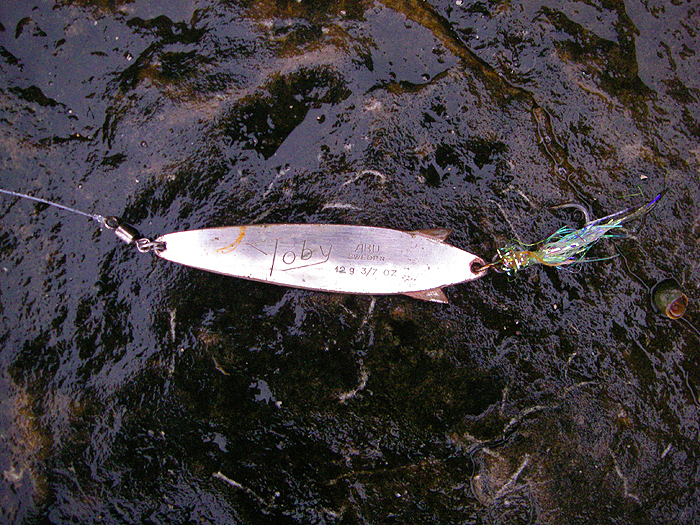
2.If you want entertainment, then fly tackle with a small plastic Delta or Redgill is the way to go. A floating line is fine at dawn or dusk when the fish often rise to the surface and move inshore.
Mackerel show most other species a 'clean-pair-of-fins' on fly gear.
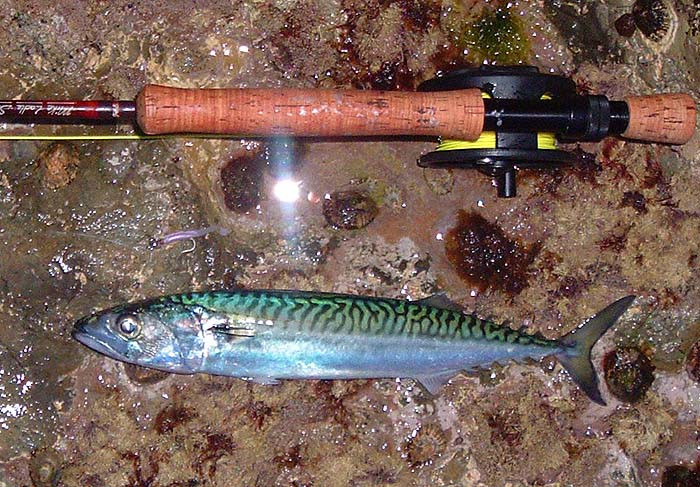
3.Small Mepps spinners Are also good mackerel catchers but do not cast as well as spoons or wedges. The spinner in the picture has a luminous body and is good in poor light. Of course, most mackerel are caught by using heavy tackle and strings of feathers, but this is for numbers rather than excitement.
At first- or last-light a spinner with a luminous body often does the trick.
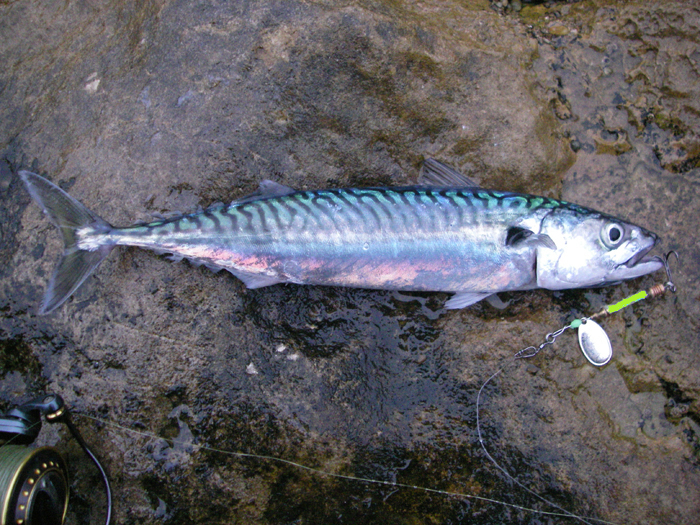
Grey mullet.
1.Baited ‘blade-spinners’ (modified Mepps type) really are deadly for thin-lipped mullet, both in salt- and fresh-water. Ragworm seems to be the best bait, although prawns, clams and earthworms (and possibly other baits) all tempt fish. The technique is to wind steadily and slowly allowing the fish to suck at the bait and hook themselves. In fast flow some weight may be needed to keep the lures sub-surface. The distance of the baited hook behind the blade can range from 5 to 20cm.
A thinlip caught from freshwater (above the tidal limit) on a ragworm baited spinner.
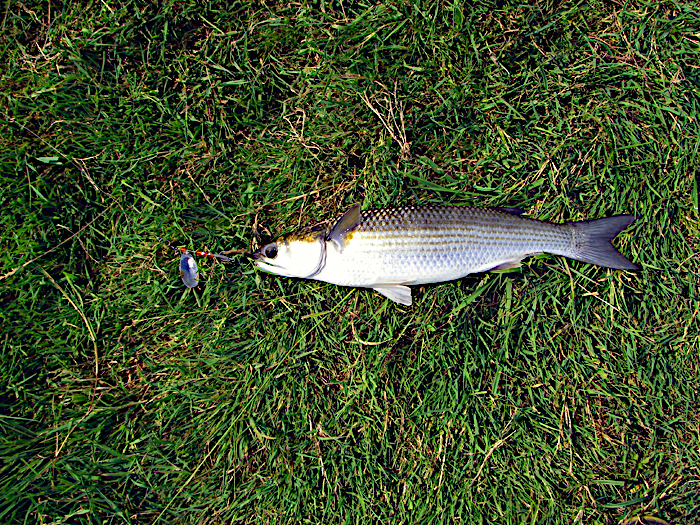
The leaded body may help keep the lure sub-surface in fast flows.
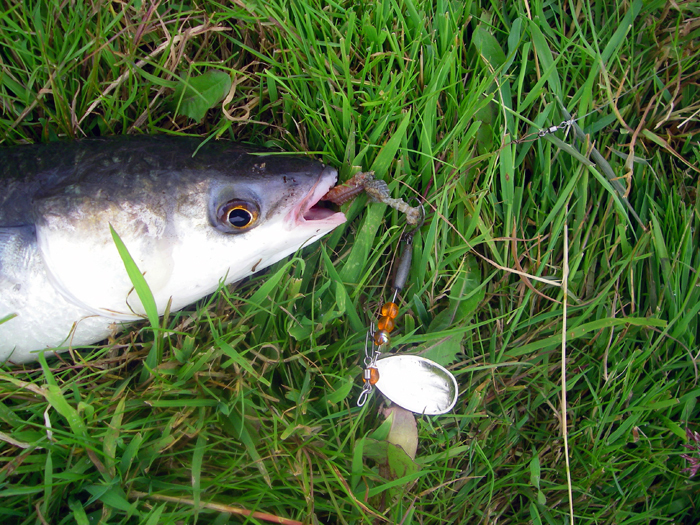
2.The original, lightweight, Jen-spoon baited with ragworm on its treble hook caught this thicklip. This species seems to be much less susceptible to baited lures than the thinlip. I soon stopped using trebles on this type of lure.
A Jen-spoon and my first 'spooned' thicklip from the sea-shore.
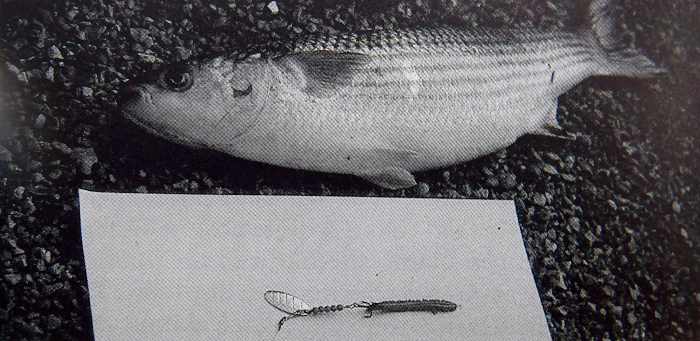
Perch.
1.Mepps and similar spinners, frequently with an added tassel on the hook, are popular with perch anglers and they certainly catch lots of perch. Arguably, since small perch take them well (and small perch are often numerous), they may not be the most selective lures for larger specimens.
A typical Mepps-caught perch.
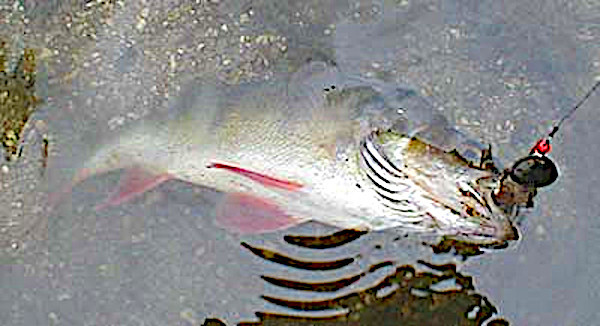
...and another one.
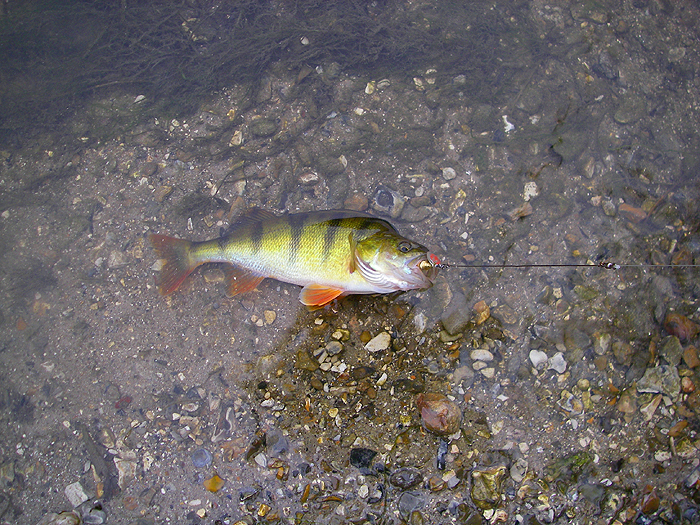
2.Plugs, including sinking versions,are good second-choice perch lures and since they can easily be scaled up may be more effective for larger specimens than spinners.
...and another one.
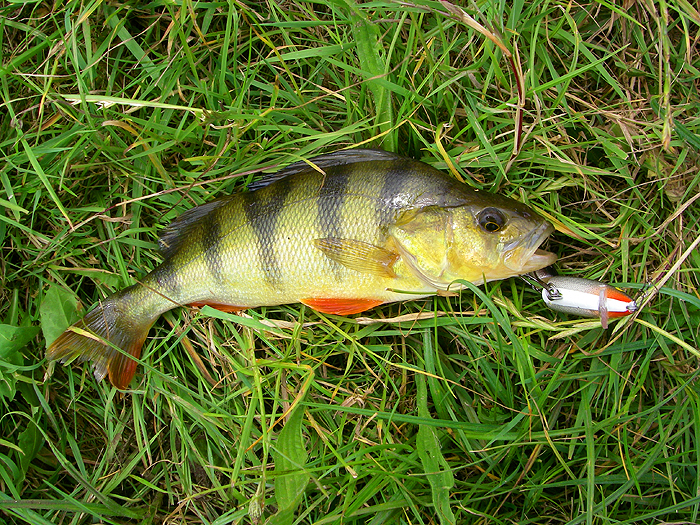
3.Soft-plastic lures are good excellent, versatile, perch lures and give the option of fishing under the rod tip close to snags.
A jigged perch on a brightly coloured soft-plastic lure.
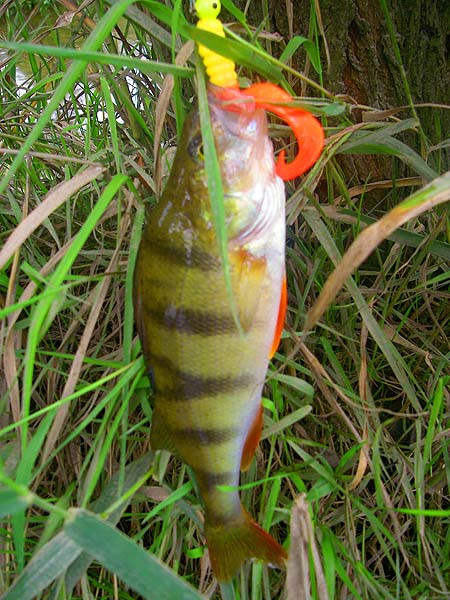
4.Large soft-plastic lures and spoons are, at times, good for bigger perch.
A much better perch on a white, unweighted, Super-Sandra, softbait..
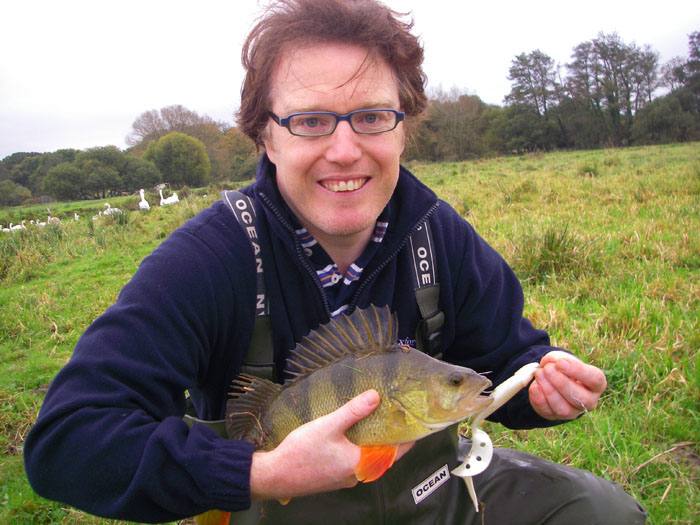
This was one of several good fish taken, in succession, on a big 'pike' spoon.
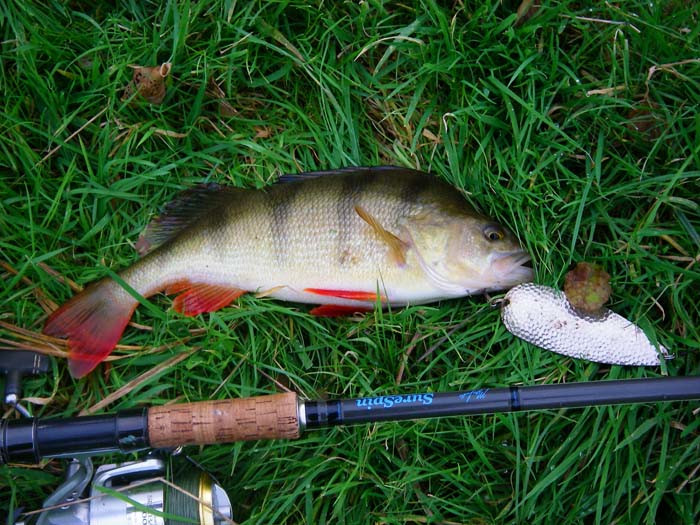
Pike.
1.Large, weedless, soft-plastics cast well, and can be fished very slowly through snags and thick weeds. Being armed with a good-sized, single hook they are excellent pike lures (much kinder to the fish than are the ‘Bulldog’ types – which are heavily weighted and draped with crude hooks). The Slandra, my home-made combination of Slug-Go and Super Sandra, often survives the teeth of the pike for quite a while and tooth cuts in the plastic can easily be mended..
A nice pike caught on a hybrid, weedless, 'Slandra' lure..
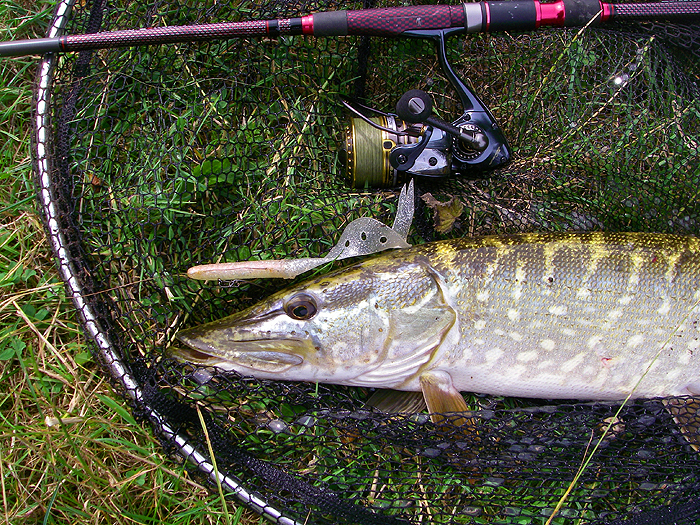
A bigger pike on the same lure.
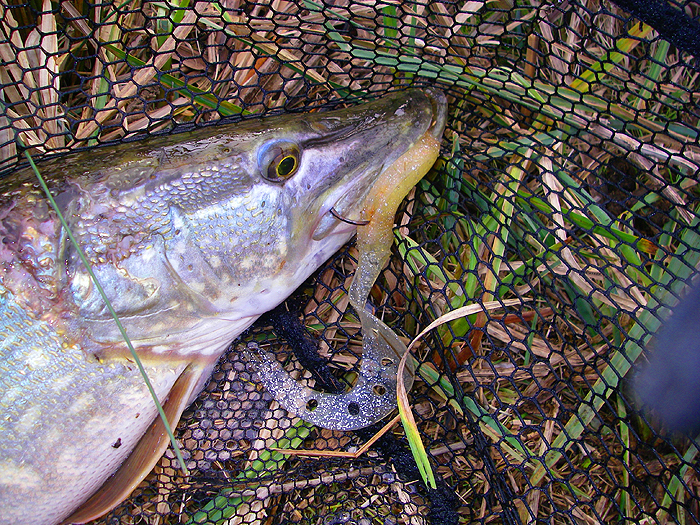
2.Large spoons and plugs also catch plenty of pike (but are less snag-free). In truth, nothing competes with a good-sized fish bait (live or dead) for the bigger pike.
Big, old-fashioned spoons are still effective for good pike.
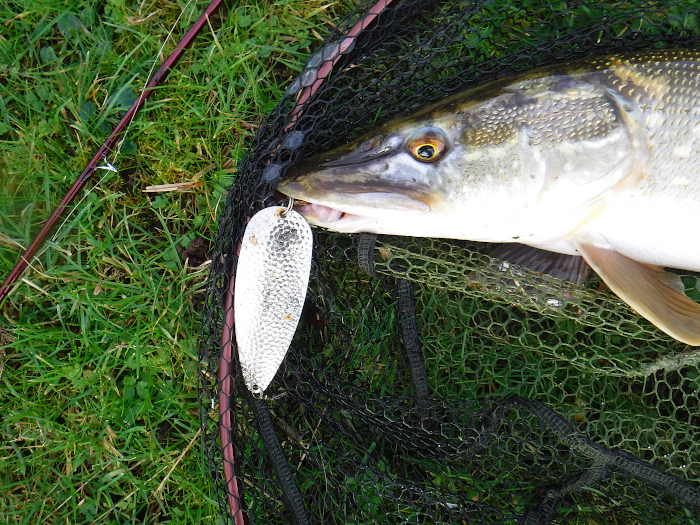
Plugs also work well but have more hooks than I like. Singles are better.
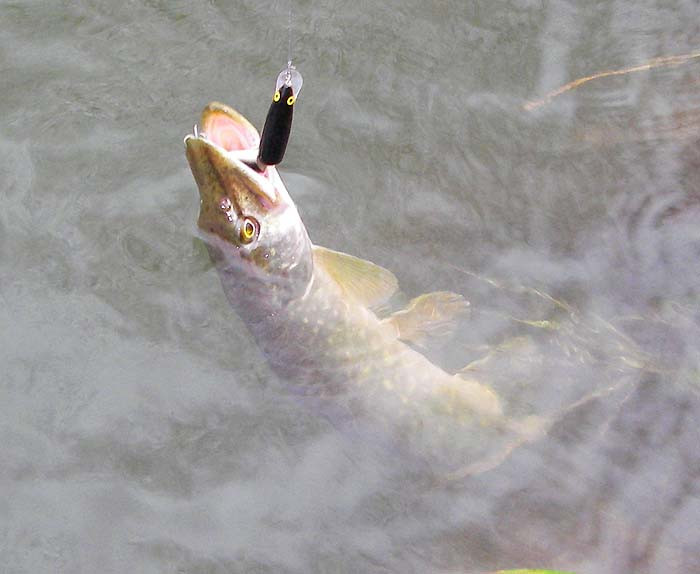
Pollack.
1.The old fashioned, 180mm Redgill is still as good as anything for pollack and the ‘Evo’ version with a built-in, leaded hook is ideal for most shore fishing, but often requires an added nose weight, particularly in the daylight hours.
A small pollack taken on a Pearl Evo-Redgill.
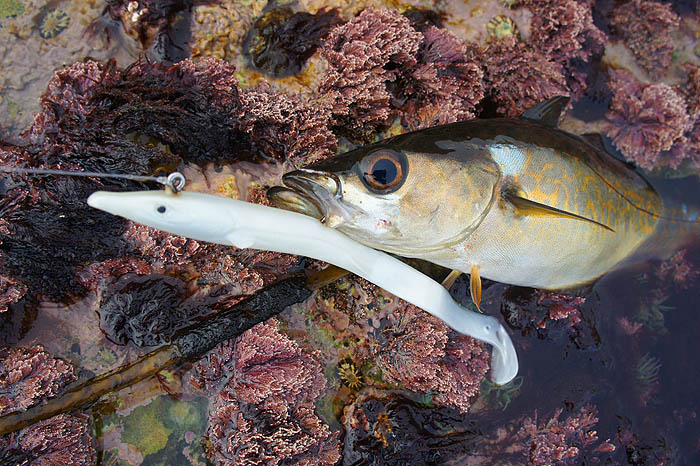
...and a slightly bigger one.
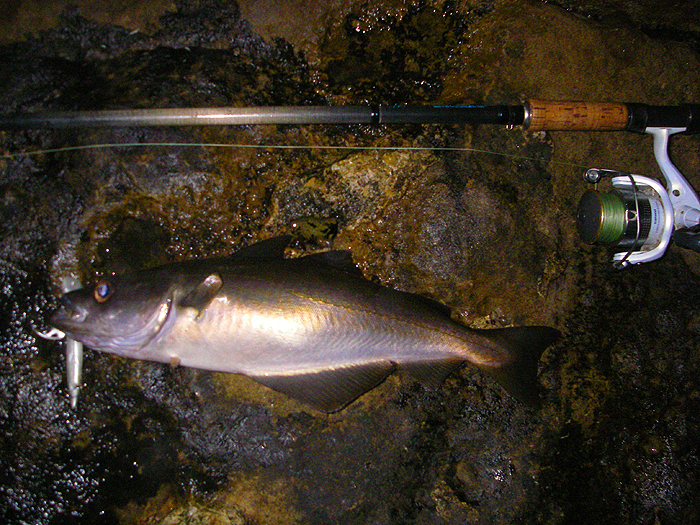
2.Fly fishing with a small (3 to 6cm) Delta or similar plastic eel is excellent for smaller pollack (the ones I usually catch). Changing the hooks for stainless versions and binding the shank with thread will stop the eel slipping down to the bend. Spoons and plugs also catch plenty of pollack.
Small Delta eels are good pollack 'flies'.
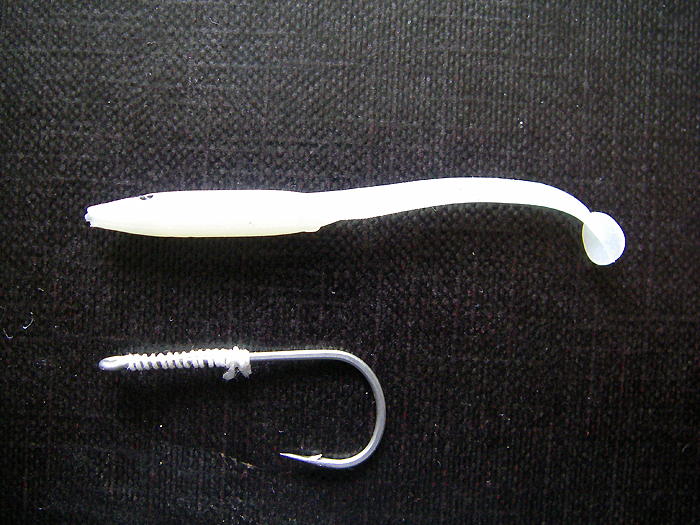
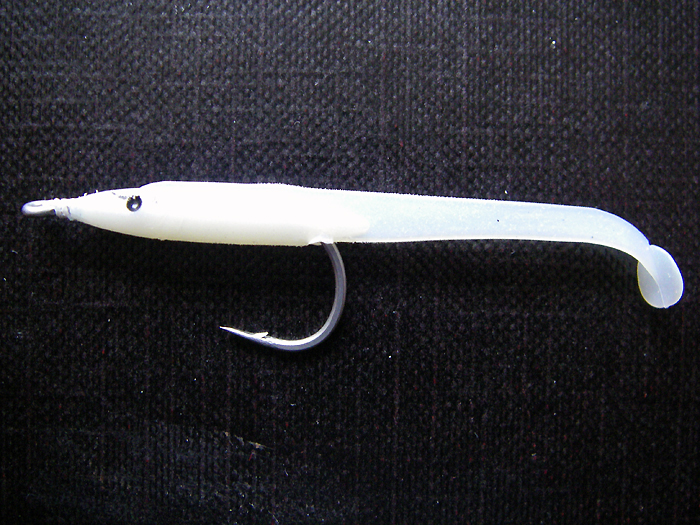
Grandson Ben (years ago) with a nice, fly-caught, pollack on a Delta, at dawn.
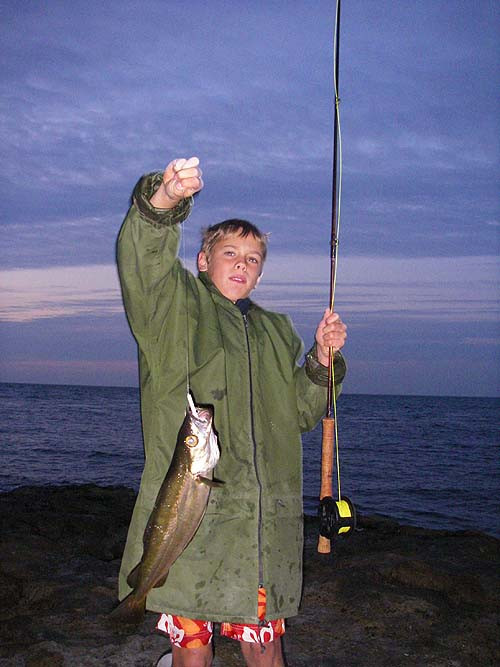
Salmon.
1.I don’t really have a ‘go-to’ lure for salmon fishing and as it is years since I’ve intentionally fished for them (I still catch them, as they often take seatrout lures) I have a slightly different slant on the subject of lures. On the rivers I fish salmon are usually in ‘lies’ near the river-bed in the main flow, so the object is simply to fish the lure in these places for the greatest amount of time. One of the easiest ways to do this is by bouncing a lure down the current. Wooden Devon’s on a paternoster are a tried-and-trusted way to do this. They fish at a fixed depth and it is easy to do when the flow is under the near bank. The only trick is to loop the weight on so that it can easily and quickly be changed for different current speeds (and depths). Plug baits, either buoyant (shallow water) or sinking (deeper water) are a good alternative and, although it needs a bit more skill to keep them in position A, they make it possible (easier) to fish where the main flow is mid-river. .
The easy way to fish a wooden Devon.
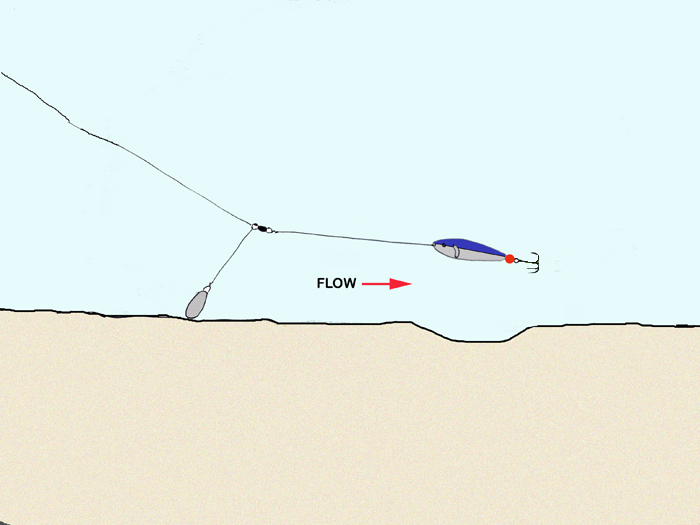
A plug-caught salmon.
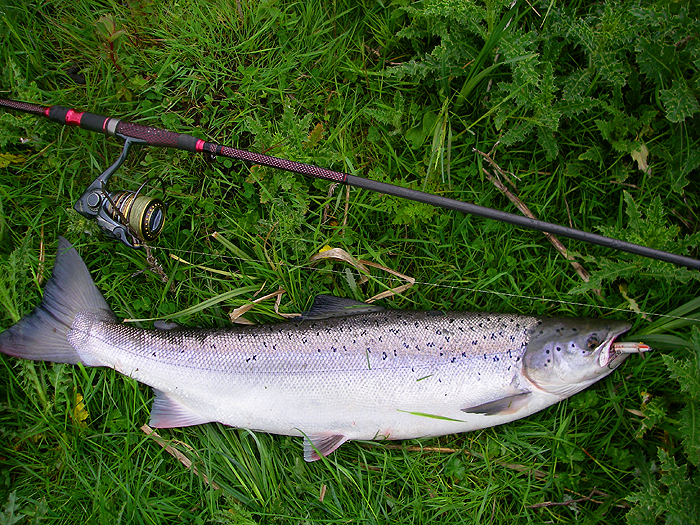
2.Spoons, spinners and flies (including soft-baits and shads) of various kinds will all take salmon and each may have advantages on occasion.
This one took a Mepps spinner.
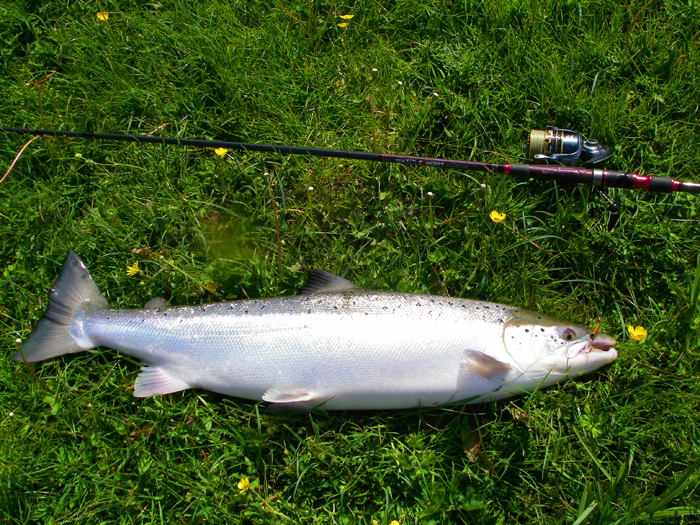
...and one on the fly gear.
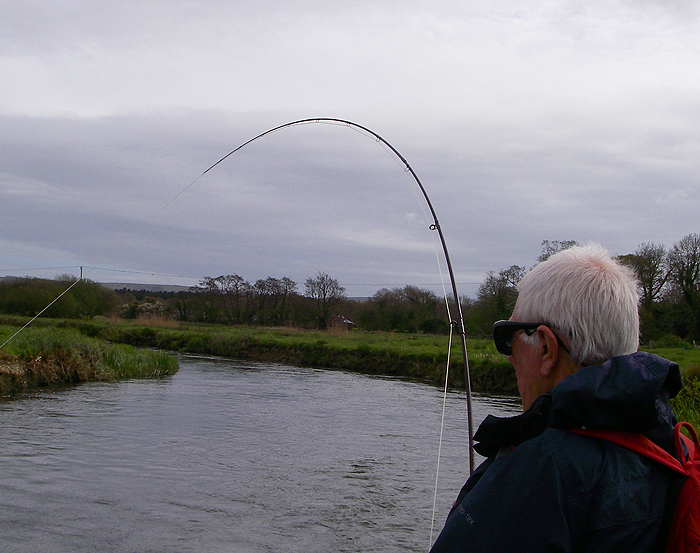
Back it goes - almost 20lb on the fly.
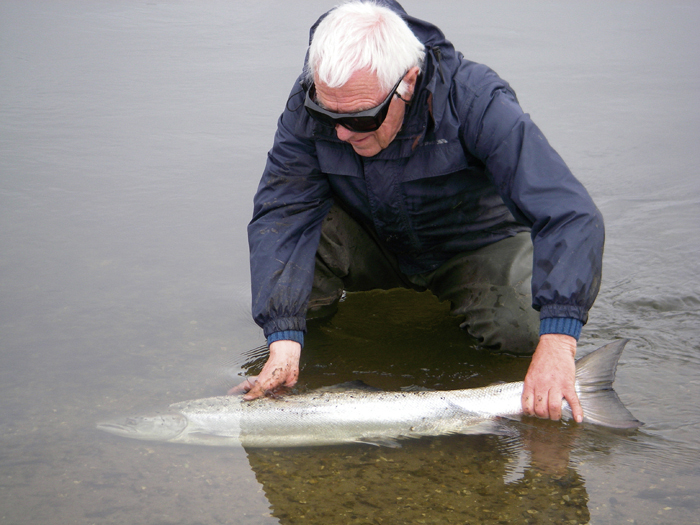
Scad.
1.Flies, including plastic Delta eels are excellent for tempting scad which feed on a wide range of small fish and plankton animals. These fish often feed well in the dark and will congregate near sources of artificial light (street-lamps etc.).
Dave Cooling with a scad taken on the fly gear.
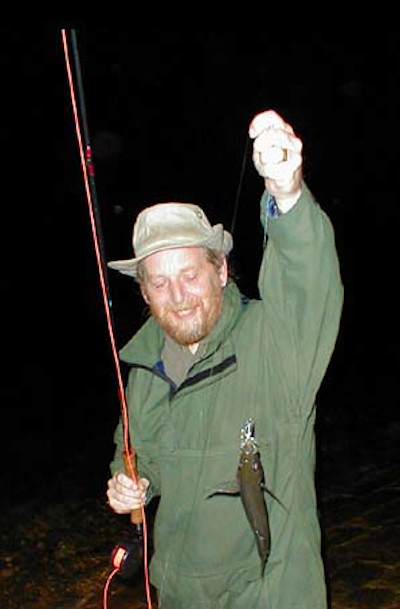
This one took one of my Deltas.
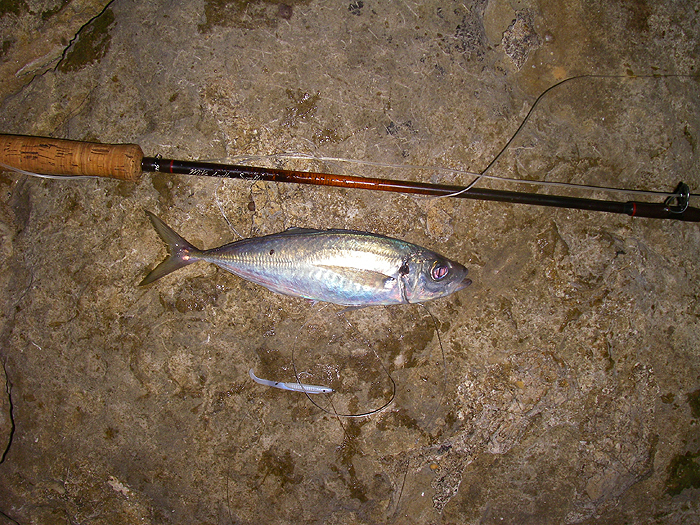
And this one took a home-made-silvery fry-fly.
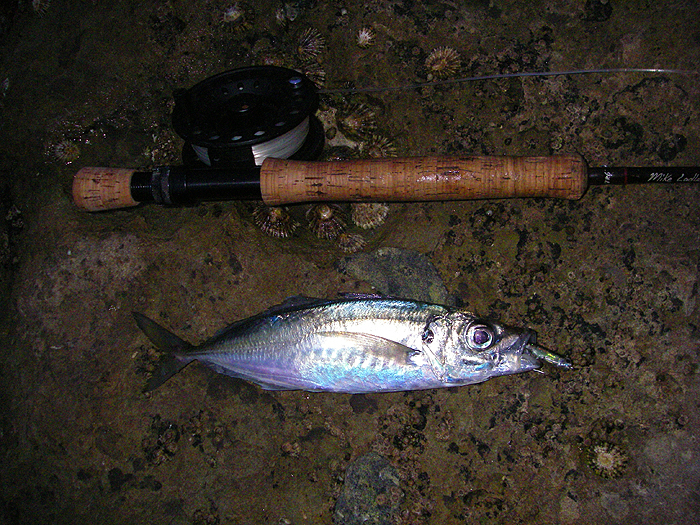
2.Small, luminous spinners are also excellent scad lures. By fitting a Mepps type spinner with a Beta-lite body makes it easy to catch scad in the dark.
A nice one on the 'Lumilure'.
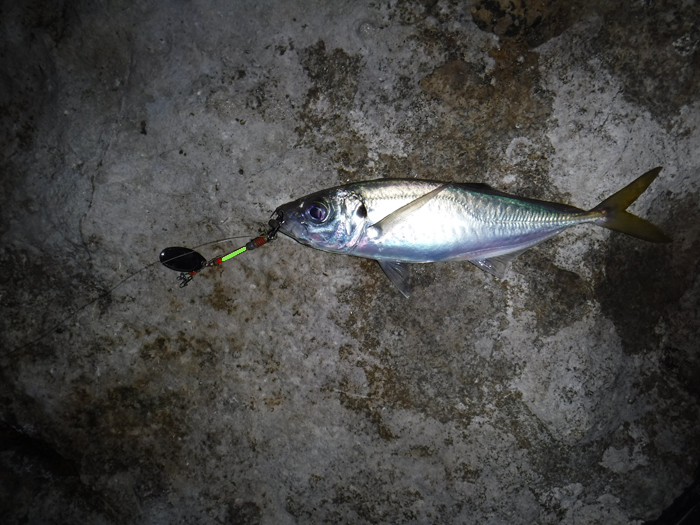
They really do glow in the dark.
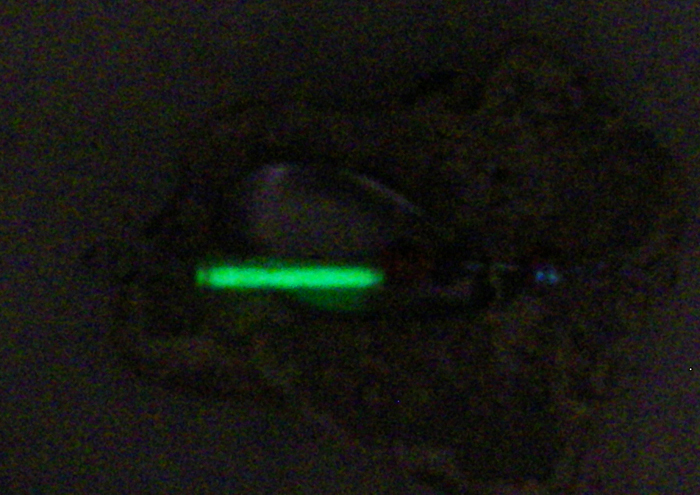
The Beta-lite is inside a length of clear shrink-tube.
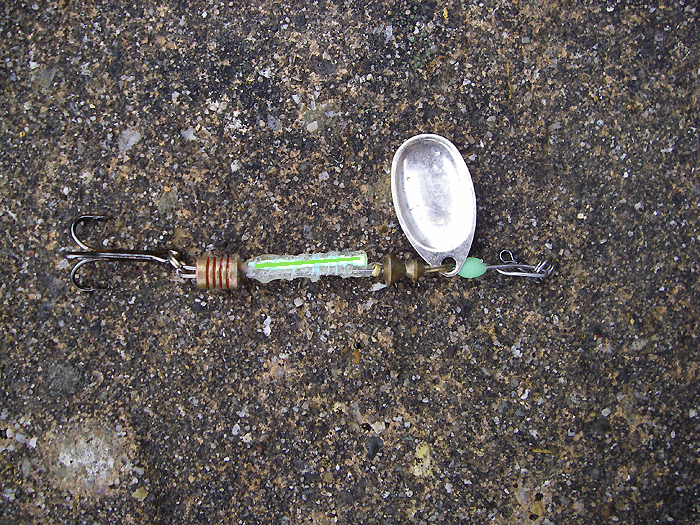
Seatrout.
1.Small, jointed, buoyant, Rapala plugs have served me well with seatrout. They are easily fished down-and-across even in shallow, weedy water and fast flows. Since pike (sometimes large ones) are usually present in the rivers that I fish a 15lb wire trace is required. Dusk and the first hour of darkness is often the prime time for these fish, whatever the lure.
A nice one on the black and silver Rapala.
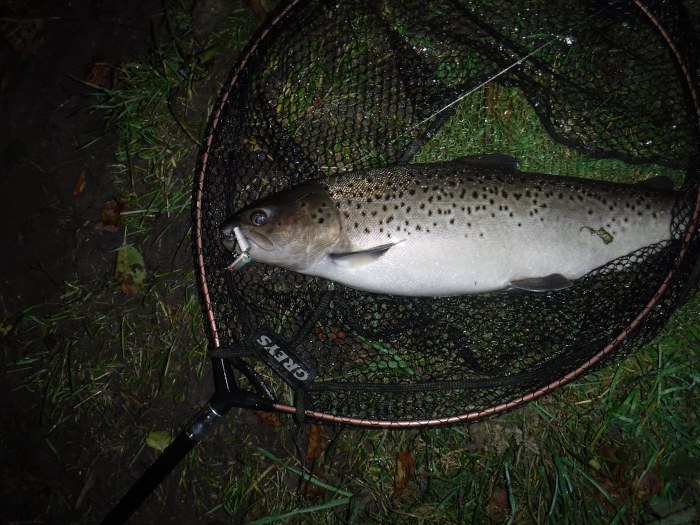
...and another good fish on the jointed plug.
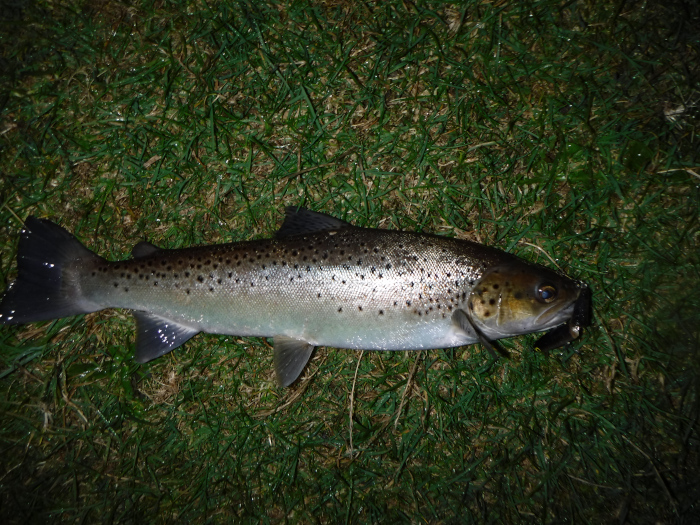
2.The luminous spinner (the same one I use for scad) is also a good choice for seatrout in the hours of darkness. Not quite as easy to control as a plug when you don't know where the lure is 'fishing' though.
The luminous spinner is effective for seatrout of all sizes.
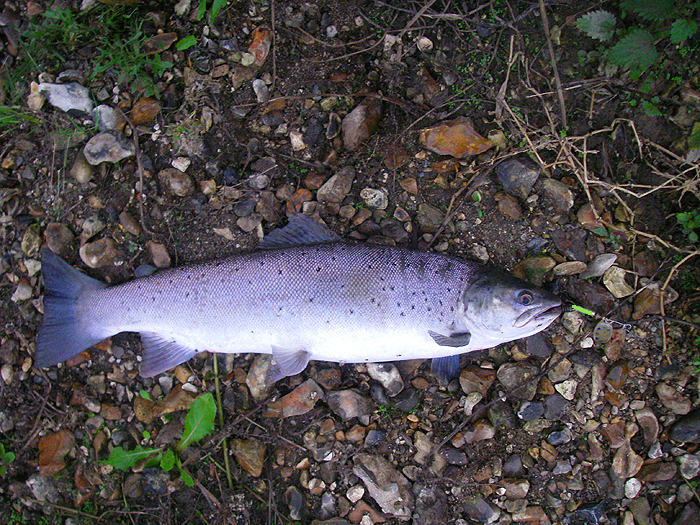
A closer look at the same fish.
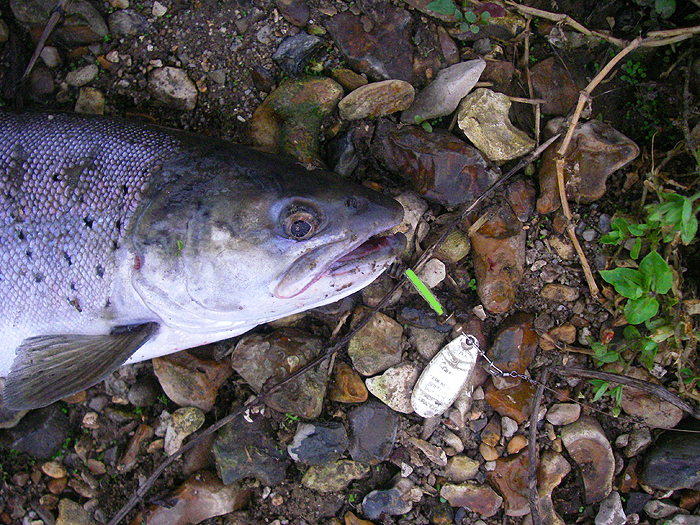
Snook.
1.Large, weedless, soft-plastics are the lures which have produced the most and largest snook for me. In many ways snook are like our own bass. They have broad tastes in the nature of their prey and consequently take a wide variety of lures. The lures should probably be selected according to fishing conditions which often involve the murky, weedy water beloved of the species. Large, unweighted, Slug-Gos and Slandras and resin headed Black Minnows are all good for big snook.
A big snook on a white Slug-Go.
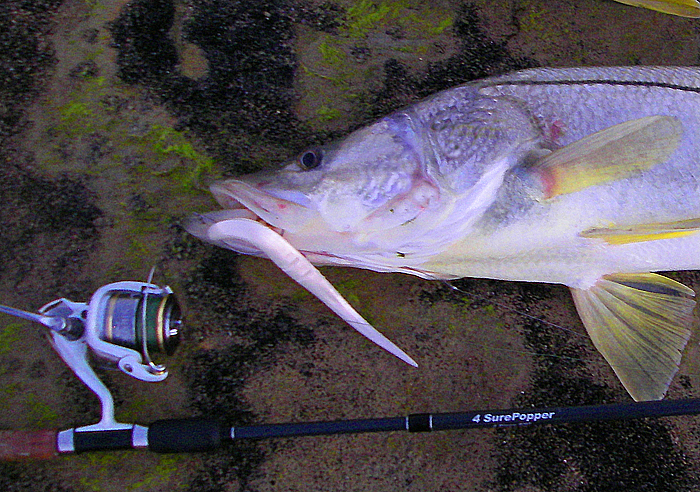
One on a 'Black Minnow' for my son Richard..
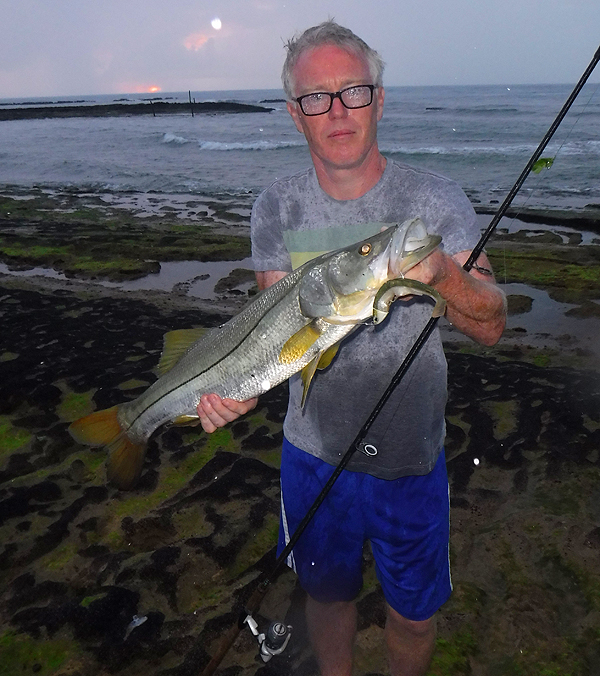
2.Plugs are also good for snook if the conditions are right (not too much weed and rubbish in the water)
A modest snook on a plug from the beach.
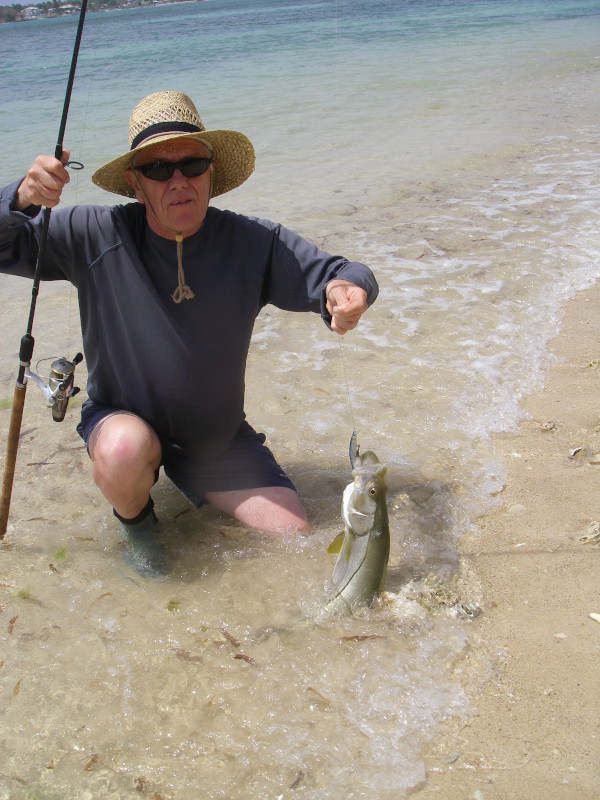
One on a plug for Richard in the gloom.
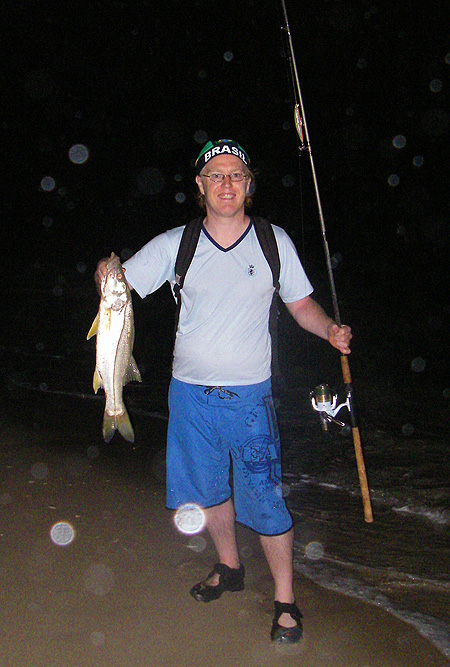
This one, well over twenty pounds, took my plug in shallow. murky water.
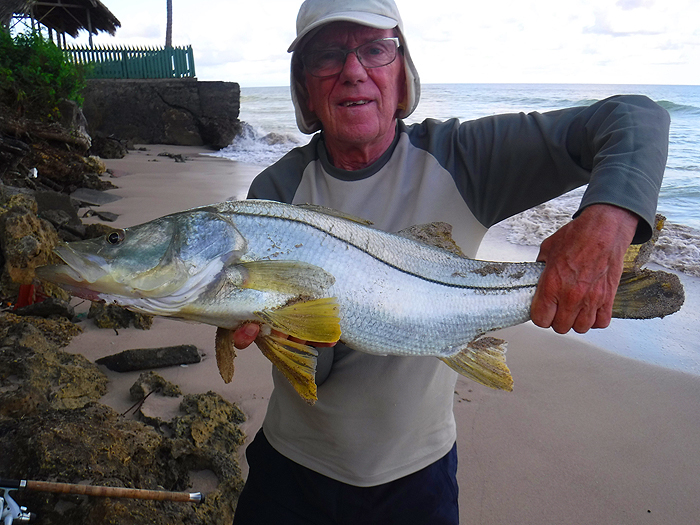
Striped bass.
1.Large soft-plastics such as Slug-Gos and Slandras are very good lures for stripers in many places. If there is a lot of tidal movement, they require a lead head to get them down. However, the lures are often massacred by bluefish so you may need a large supply of lures. I've only fished for striped bass on one trip so I'm no expert.
A small striper on a jigged softbait.
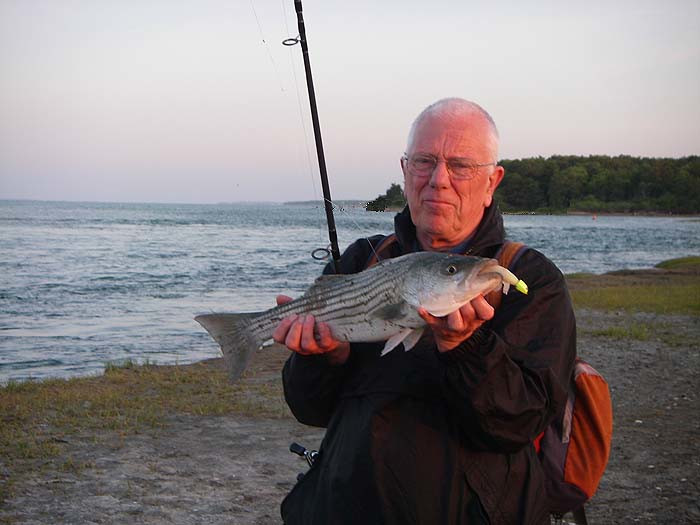
A better one which took one of my Slandra lures, right in the weed at the edge, just where I'm standing.
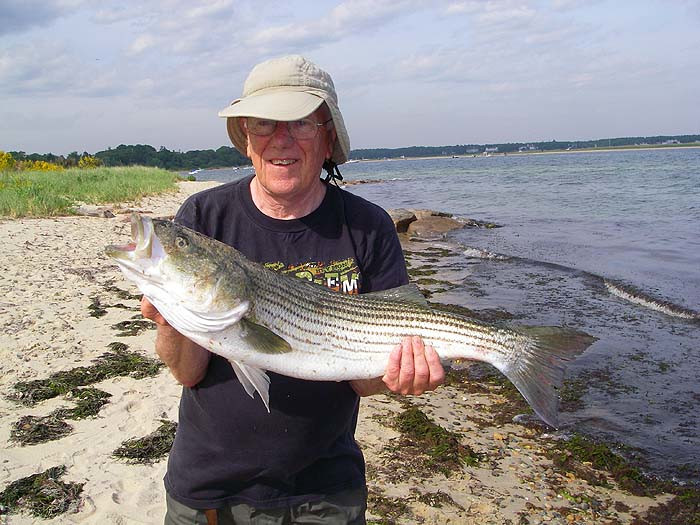
2.Very big stripers are often caught by specialist anglers (like my pal Thieu, pictured) using powerful rods and extremely large, lipless lures, to fish areas where the fish are known to migrate.
Fishing the Cape Cod 'Canal' at change of light.
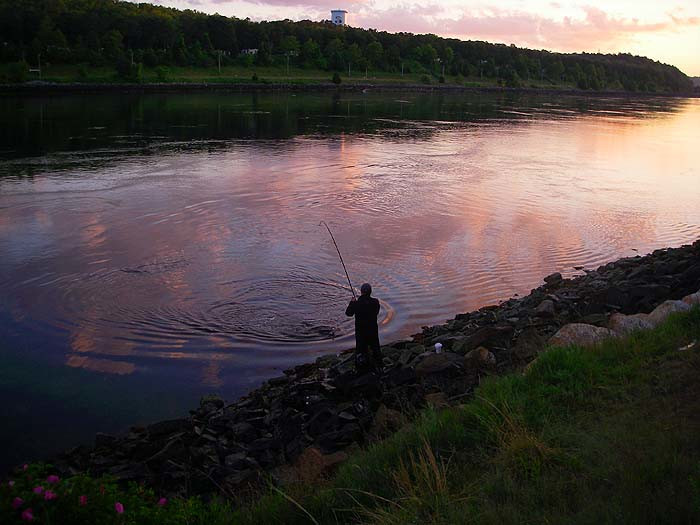
A large striper lure compared to one of my good-sized, buoyant plugs..
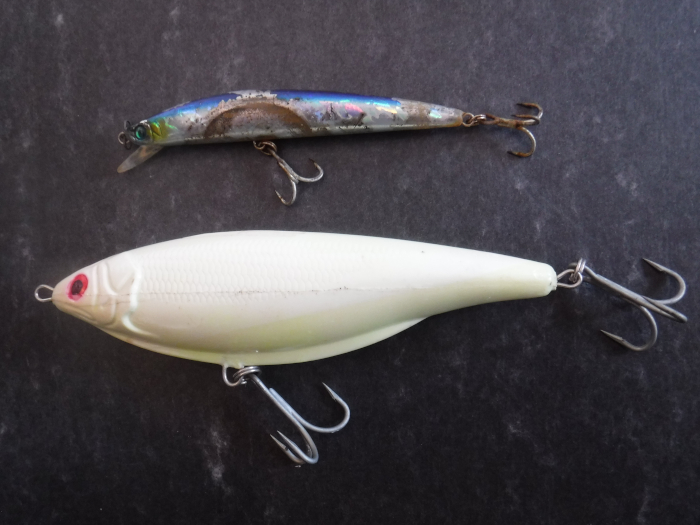
Thieu, a striped bass angler who really knows what he's doing, with a big fig fish from the Canal..
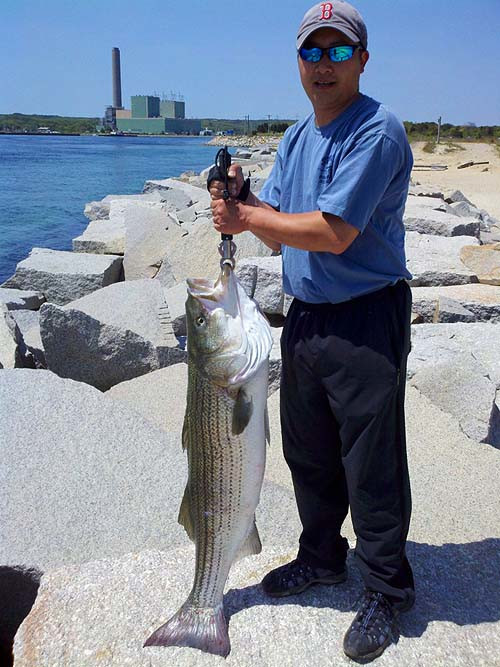
Tarpon.
1.Hard surface and sub-surface lures (with strong hooks) will catch large tarpon from the beach, but softbaits are also good for these fish, as are dead and live fish baits. Although the fish will take all sorts of lures, they often throw the hooks, particularly if the lure is a heavily weighted one.
A decent tarpon landed, single handed, on my 'bass spinning tackle' from the shore in Tobago.
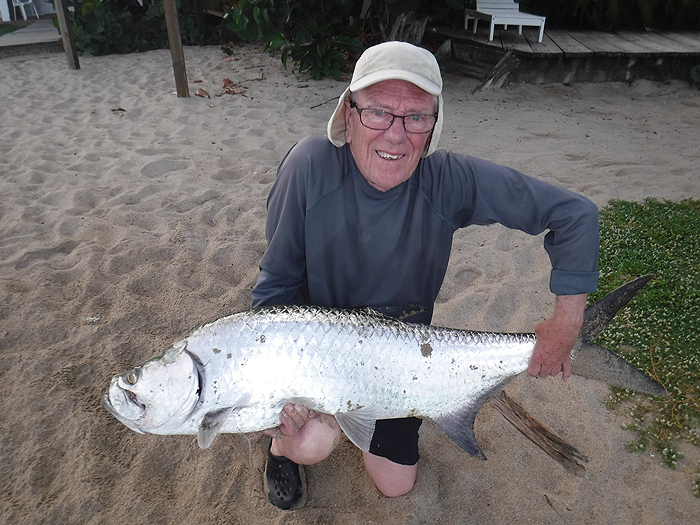
A much bigger one caught by my pal Steve Pitts in the evening.
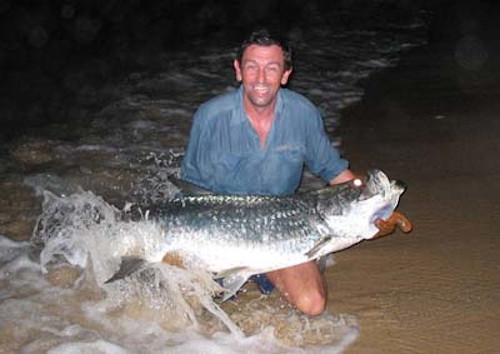
2.Small, light-weight plugs and flies catch plenty of tarpon and the sport, even with baby ones, can be spectacularly exciting.
This one took a while to bring to the beach on a small, jointed Rapala.
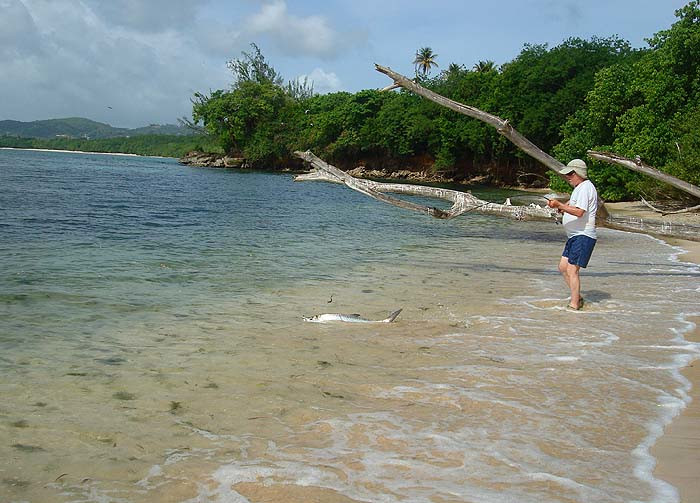
No monster but I'd recently lost a much bigger fish on an identical small plug when it 'spooled' me after a prolonged battle on 13kg braid.
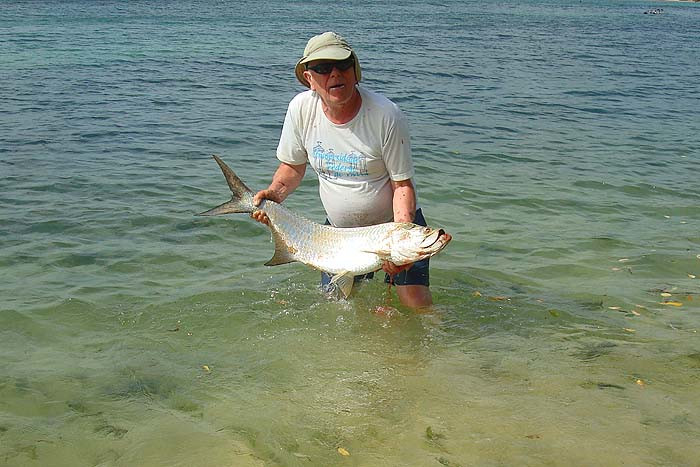
A typical, fly-caught, tarpon for Steve; they find it more difficult to throw the hook of lightweight lures..
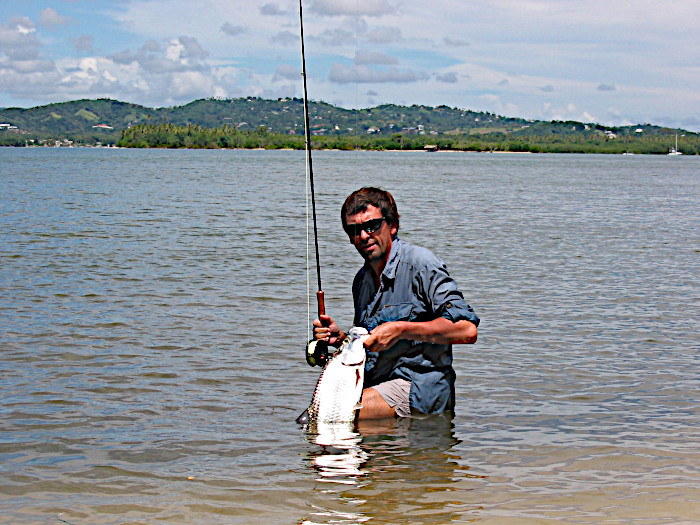
Wrasse.
1.It is now more than fifty years since my pals and I learned to catch wrasse on plugs as a by-product of spinning for bass. I have now caught a great many of these fish and at times have specialised in fishing for them. Lures tend to select for larger wrasse and the fish are much less likely to resort to the typical snag-seeking behaviour than when they are caught on baits.
A decent ballan wrasse, typically hooked on the tail treble of a long-bodied plug .
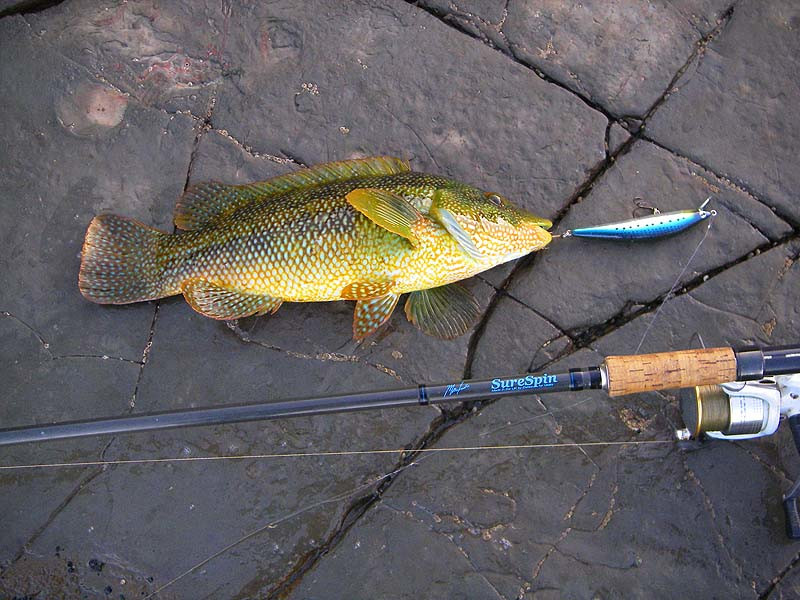
Another good wrasse on a Rapala.
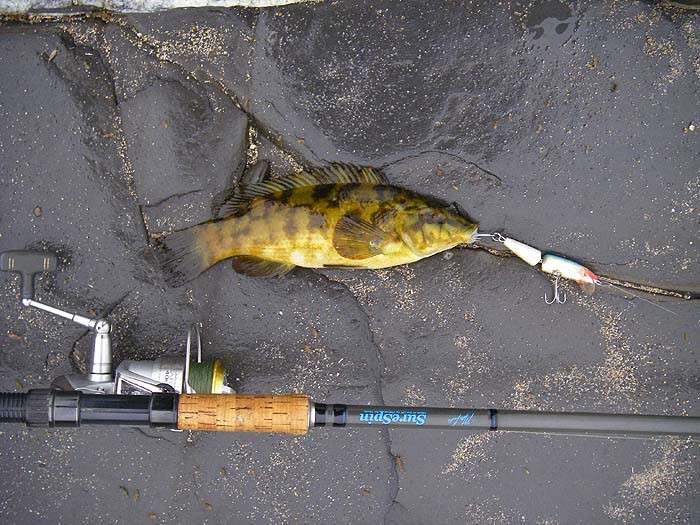
A good one for Steve Pitts.
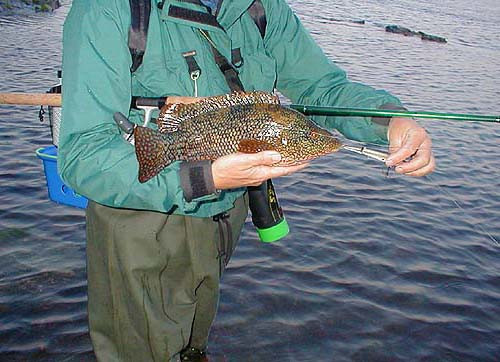
2.Wrasse like crayfish imitations and weedless soft-plastic lures too.
This one took a 'Rebel Crawfish'.
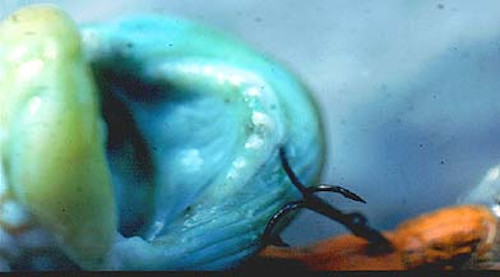
...and this good specimen took one of my Slandras.
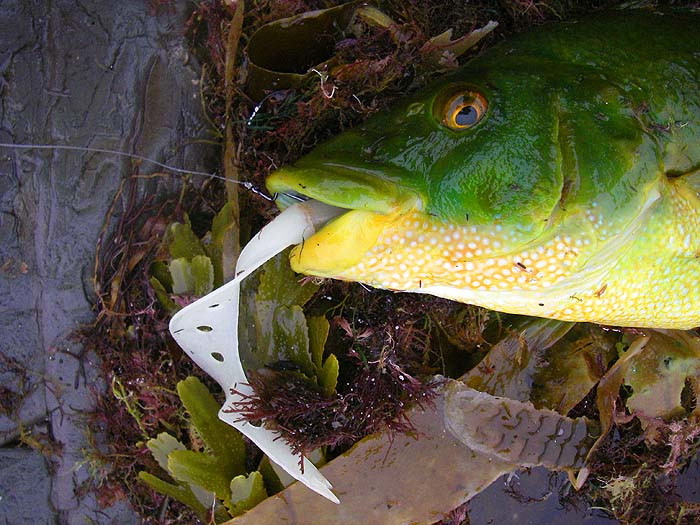
– PLEASE TELL YOUR TWITTER, FACEBOOK, EMAIL FRIENDS ABOUT THESE BOOKS.
ANGLING ON THE EDGE
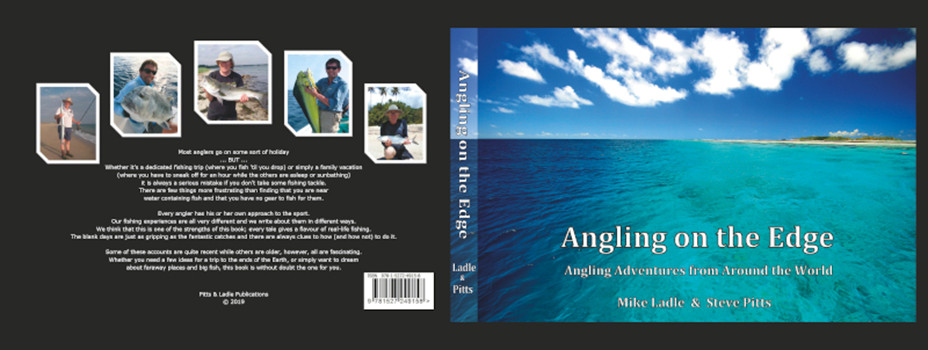
Copies can now be ordered (printed on demand) from Steve Pitts at £34.00, inc. Royal Mail Insured UK Mainland Postage.
To order a book send an E-MAIL to - stevejpitts@gmail.com
FISHING FOR GHOSTS
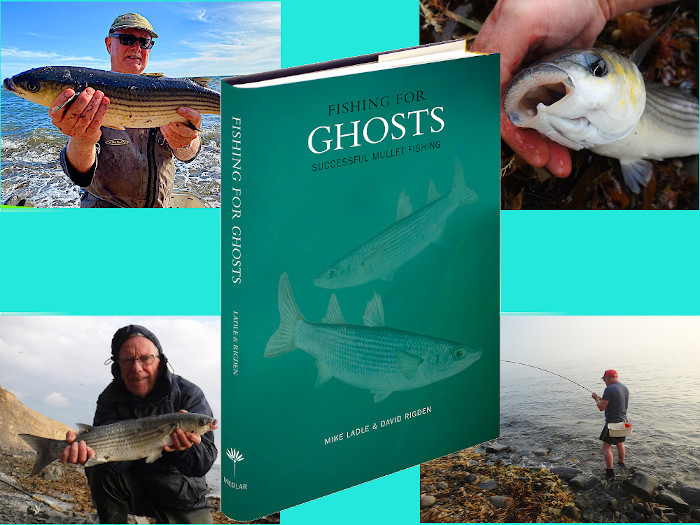
Written with David Rigden. Copies from
THE SECOND WAVE

Written with Steve Pitts this is a SEQUEL TO THE BESTSELLER "Operation Sea Angler" IT'S AVAILABLE ON PAPER FROM -
If you have any comments or questions about fish, methods, tactics or 'what have you!' get in touch with me by sending an E-MAIL to - docladle@hotmail.com